
The global authority in superyachting
- NEWSLETTERS
- Yachts Home
- The Superyacht Directory
- Yacht Reports
- Brokerage News
- The largest yachts in the world
- The Register
- Yacht Advice
- Yacht Design
- 12m to 24m yachts
- Monaco Yacht Show
- Builder Directory
- Designer Directory
- Interior Design Directory
- Naval Architect Directory
- Yachts for sale home
- Motor yachts
- Sailing yachts
- Explorer yachts
- Classic yachts
- Sale Broker Directory
- Charter Home
- Yachts for Charter
- Charter Destinations
- Charter Broker Directory
- Destinations Home
- Mediterranean
- South Pacific
- Rest of the World
- Boat Life Home
- Owners' Experiences
- Interiors Suppliers
- Owners' Club
- Captains' Club
- BOAT Showcase
- Boat Presents
- Events Home
- World Superyacht Awards
- Superyacht Design Festival
- Design and Innovation Awards
- Young Designer of the Year Award
- Artistry and Craft Awards
- Explorer Yachts Summit
- Ocean Talks
- The Ocean Awards
- BOAT Connect
- Between the bays
- Golf Invitational
- Boat Pro Home
- Pricing Plan
- Superyacht Insight
- Product Features
- Premium Content
- Testimonials
- Global Order Book
- Tenders & Equipment

Where are they now? 6 famous America's Cup yachts
1851 schooner america’s sad demise.
In 1851, the schooner America , sailing for the New York Yacht Club, beat the Royal Yacht Squadron and laid claim to its 100 Guinea Cup. Thus the America’s Cup was born – what is now the oldest trophy in international sport – earning its name from that first winning yacht rather than the country, though the US did go on to hold the trophy for 100 years.
Where is America's Cup yacht America now?
The famous America's cup yacht America changed hands – and names – a few times after the first historic race, and then wound up in the American Civil War as a Union ship. She stayed in the military as a training ship for the Navy until 1873, when she was sold to a former Civil War General for $5,000 (about $98,000 today). The general raced, maintained and refitted the boat, but after his death in 1893, she was passed down to his son who lacked interest in the schooner and allowed her to fall into disrepair. Despite being eventually donated back to the Navy, lack of maintenance left her seriously decayed. The nail was driven into the coffin when a major snowstorm caused the shed she was stored in to collapse in 1945, and America was scrapped and burned, bringing the history of one of the most famous sailing yachts of all times to a close.
America ’s legacy lives on to do this day, and there are replicas of the schooner you can sail on to relive the glory of this historic vessel. Climb aboard the 32 metre America 2.0 replica (pictured in the inset above) in Key West (November-April) and New York (May-October), or on a 42 metre replica out in San Diego .
1930 Shamrock V is still sailing
J Class yachts are synonymous with the America’s Cup as these slim, graceful beauties once represented the fleet racing for the Cup. The 36.42 metre Shamrock V , commissioned by Sir Thomas Lipton for his fifth and final bid, she was the first J Class yacht to compete for the Cup. The fact that she is the only J Class yacht to be built in wood makes it all the more remarkable that Shamrock V is still floating today.
Where is America's Cup yacht Shamrock V now?
The Camper & Nicholsons -built J is in pretty perfect condition for a lady of her years. J Class yacht Shamrock V is currently for sale and looking for a good home. The right owner could sail away on this piece of Cup history just in time as the J Class yachts make a triumphant return to the America's Cup .
1987 movie star Stars & Stripes still racing
While the film Wind , one of the best boat movies , was inspired by Dennis Conner’s experience competing for the America’s Cup in 1983 on board Liberty , the yacht that was actually used in filming was the 12 Metre type sailing yacht Stars & Stripes 87 . She was called Geronimo in the film, but Stars & Stripes 87 was more than a screen legend. When Conner launched his own campaign, he wanted a culmination of all the Stars & Stripes yachts that came before her, and she was designed to be fast in heavy air. Stars & Stripes 87 wound up being the final 12 metre yacht to win the America’s Cup.
Where is the America's Cup yacht Stars & Stripes 87 now?
Stars & Stripes 87 can be found in the Caribbean now, able to be sailed with the St Maarten 12 Metre Challenge , giving you a chance to take the helm (if you're lucky) of a real Cup winner.
1988 Stars & Stripes multihulls
Paving the way for the high-performance multihull America's Cup yachts that are redefining the competition is Stars & Stripes – the catamaran. The first America's Cup multihull yacht, the US team's Stars & Stripes came to be by a cunning interpretation of the Deed of Gift, which only stipulated the challenging yachts be single masted and no more than 90 feet LWL. The result was anything but a true match race, with the much faster, wing-masted multihull Stars & Stripes winning the Cup in 1988.
Where are the America's Cup multihull yachts Stars & Stripes now?
Two versions of the multihull Stars & Stripes were built, a soft sail (S1) and a wing-masted yacht (H3). Stars & Stripes (S1) was acquired by American entrepreneur Steve Fossett and used to set speed records around the world before being sold in 2017 to Key Lime Sailing Club and Cottages in Key Largo, where she is used for day charters and racing. The actual Cup player, Stars & Stripes (H3) was bought by Mark Reece in Naples, Florida and was used for sailing charter trips, but her current status is unconfirmed.
1994 Stars & Stripes once used as a training yacht by Oracle Team USA
America’s Cup yacht Stars & Stripes (sail number 34) is probably most famous for not winning a Cup. It wasn’t because she didn’t perform under pressure, but because she never got the chance. While the 24 metre yacht, designed by David Peddic and built in 1994 by Goetz Boat Works, won the right to defend the Cup, Dennis Conner chose Young America (US 36) over Stars & Stripes . The new choice was no match for Team New Zealand’s Black Magic , which beat out Team Dennis Conner four times in a row.
Where is America's Cup yachts Stars & Stripes (US 34) now?
Famed America’s Cup Stars & Stripes (US 34) is earning a chance to prove herself on the racecourse yet again. She sails out of Chicago, racing against Abracadabra (US 54). After failing to win the Cup in 2000, this iteration of Abracadabra was bought by Larry Ellison, who used her as a training boat for his Oracle Team USA.
2003 USA 76 still sailing in San Francisco Bay
Sailed by the US challenging team in preparations for the 2003 America’s Cup in Auckland, New Zealand, USA 76 never made it to the Cup, but she came quite close. Making it to the Louis Vuitton America’s Cup final, USA 76 faced the Swiss Team Alinghi but didn’t come out on top. So the US team arranged for a “rematch” against Alinghi, with two races set in San Francisco Bay. While it didn’t change the results of the Cup, this time USA 76 bested the Swiss competitors twice over.
Where is America’s Cup yacht USA 76 now?
Fittingly, USA 76 resides in San Francisco Bay and is available for sailing. Capture the spirit of the most recent America’s Cup that was raced in the natural amphitheatre of the Bay by climbing aboard USA 76 for a racing adventure under the Golden Gate Bridge.
Sponsored listings

The 12m Class and the America’s Cup By Halsey C. Herreshoff
Credit: www.herreshoff.org
The 150-year history of the America’s Cup, the oldest and most distinguished prize in world sport, is summarized from the author’s vantage point of belonging to a family of boat designers and builders who contributed to the dominance of American yachts from the beginning into the 1980s. Particulars and performances of the most important designs are described from AMERICA to the current International America’s Cup Class.
Introduction
The America’s Cup is the Holy Grail of yacht racing. It is much more. This Cup, in competition for a period of 150 years, is the oldest and most distinguished trophy in all sport, outdating the World Cup, Davis Cup, Stanley Cup, Walker Cup, and all others of significance. Excepting the lavish excesses of big time modern professional sport, more talent, effort, and money have been devoted to the America’s Cup than for any other sport competitions. From the standpoint of naval architecture, America’s Cup intensity has inspired countless design breakthroughs, fallout from which benefit all yachts today to an extent generally unrealized by those who sail. Here, a highly focused pursuit of excellence has provided quality, boldness, and dedication to be the best. The most elegant hull lines, most efficient construction, best sails, and most skillful sailing techniques have evolved from America’s Cup competition.
For 132 years (1851 to 1983), the United States enjoyed the longest winning streak in all sport. There were close calls but always the U.S. won the series and most of the individual races. Through that time, American yachts were generally, though not always, the fastest; thus, it may be fairly stated that victories followed very much from technical prowess.
As with any ship design, a sailing yacht embodies many necessary elements, which must dovetail to accomplish its mission. What is nice about America’s Cup design is that the only mission is speed, maneuverability and reliability to best a single match race rival around a closed course. Size, weight, wetted surface, hull form, light but strong construction, efficient rigs with good sails, sea kindliness and maneuverability are necessary. In general the successful boats embody acceptable or superior selections in the above categories. Bold innovation has been rewarded, but nearly always, extremes have failed. In a series of yacht races encompassing generally a variety of wind and sea conditions, an overall good boat wins.
It is appropriate to divide America’s Cup history into seven logical chronological divisions. The outstanding or most interesting yacht of each period will be addressed herewith. Listed below are the America’s Cup competitions by era with the names of the winning and defeated yachts respectively. In each case the focus yacht is in boldface type.
The l2-Metre era: 1958-1987
Following World War II, the conventional wisdom on both sides of the Atlantic was that the America’s Cup was done. The world was rebuilding and there seemed little prospect of funding further J boats given their assumed greatly accelerated cost. The Cup itself remained the pride of the New York Yacht Club, continually on display in the trophy room of the 44th Street Club House. Most of us expected it to just remain there for a long time, perhaps never to be raced for again.
Enter Commodores Henry Sears and Henry Morgan of the New York Yacht Club. By petitioning the Supreme Court of the State of New York, they modified the Deed of Gift to allow smaller yachts without the previous demand that challengers must cross the ocean on their own bottoms. It was agreed to compete in the International 12-Metre Class, which had provided excellent racing for several years before the war. Designed to the rather tight specifications of the International Rule, these boats did not really fit the grand traditions of the Cup but nevertheless provided nearly three decades of some of the finest match racing ever.
1958-1987: The 12-Metres 1958 COLUMBIA vs. SCEPTRE 1962 WEATHERLY vs. GRETEL 1964 CONSTELLATION vs. SOVEREIGN 1967 INTREPID vs. DAME PATTIE 1970 INTREPID vs. GRETEL II 1974 COURAGEOUS vs. SOUTHERN CROSS 1977 COURAGEOUS vs. AUSTRALIA 1980 FREEDOM vs. AUSTRALIA 1983 AUSTRALIA II vs. LIBERTY 1987 STARS & STRIPES vs. KOOKABURRA III
I can write more knowledgeably about the 12-Metre era than any other, as I was an active participant for 25 years and an observer for the full 29 years. Through acquaintance with Harry Sears, I was excused from other duties as a naval officer to sail aboard COLUMBIA, the 1958 Cup Defender, as bowman. Sailing aboard the 12’s in most of their seasons, I participated in four America’s Cup series, a total of 20 races; it was all about the greatest fun I’ve ever had.
The International Rule is an inelegant arbitrary formula that controls and restricts the design of these boats within narrow limits. There is a minimum length, maximum draft, maximum rig heights, and a set relation between length and displacement. Scantlings first in wood and later in aluminum are tightly controlled by specifics of the rule, Nevertheless, innovation in design particularly by Olin Stephens brought about nearly continual improvement of the boats, and the design edge of the United States long seemed to assure retention of the Cup as it did over many matches through 1980.
Curiously, some of the finest racing of all was in the finals of the first selection trials between COLUMBIA, sailed by Briggs Cunningham and designed by Sparkman & Stephens against Stephens prewar 12-Metre VIM. These were great tactical battles with racing margins of a few seconds in many races. The Cup race itself that year was a walk; SCEPTRE was a quite inferior design that had never faced competition before the match. As had happened a few times before, WEATHERLY, a weak American boat, won in 1962 by the brilliance of Bus Mobacher, her skipper. That was the first year of an Australian challenger and GRETEL won a race demonstrating the aggressive posture of Australian sailors.
Another S&S yacht, CONSTELLATION won in 1964. She was a quite elegant all-round boat, which was selected as Cup Defender over the large and powerful AMERICAN EAGLE, which was only superior in heavy weather. This should have been a tip off to the future but the true significance of having to design the smallest possible 12-Metre for Newport conditions was not generally appreciated until Australia II lifted the Cup in 1983. The reason 12-Metres form an exception to the axiom “design big” is the idiosyncrasy of the rule, particularly the prescription of increased displacement with length.
Olin Stephens’ INTREPID of 1967 was a breakthrough yacht. Wetted surface was drastically reduced with a shorter keel and separate rudder and the boat had numerous refinements. With outstanding management and the skill of Mosbacher again as skipper, INTREPID was unbeatable. The quest for further breakthroughs led to some peculiar and unsuccessful designs over the next two seasons.
The 1970 match was saved by repeat defense of INTREPID. In 1974, Olin Stephens designed another very fine boat, COURAGEOUS. Built of aluminum under new scantling rules, COURAGEOUS was powerful and superior in a breeze but did not easily defeat INTREPID, striving for a third defense. The selection trials reduced to a memorable sudden-death race in a 30-knot northeast breeze that COURAGEOUS won through both superior speed and better sailing. While I personally believe that Stephens’s 1977 boat, ENTERPRISE, was a further improvement in the same direction, Ted Turner sailing COURAGEOUS beat her out for the defense. Though not of demonstrably different dimensions, FREEDOM of 1980 seemed very superior. One difference was lower freeboard – providing a lower center of gravity and less hull windage. The new ingredient was a brilliant program of development of sails, gear and crew established by skipper Dennis Conner over a two-year program. The success of the program altered America’s Cup procedures from then on. Even with that, FREEDOM did lose one of the races of the match principally owing to a light-air advantage of Australia employing a rule-beating mainsail that gave her superior windward speed in light air.
Then, in 1983, the unthinkable happened in Newport when AUSTRALIA II beat LIBERTY in “The Race of the Century,” the sudden-death seventh race of that match. AUSTRALIA II was the best 12-Metre yacht to sail in the 25-year history of competition at Newport. Her extraordinary and controversial winged keel was, of course, the conspicuous feature. The ballyhoo about that masked the significant facts that AUSTRALIA II was the first boat to go to minimum 12-Metre length and displacement and that she had significantly less wetted surface than any other Twelve; this latter fact won the Cup! Less wetted surface followed naturally from a smaller boat but also from a keel of radically small planform. Where that had failed 13 years earlier in VALIANT with a conventional keel, it succeeded in spades on AUSTRALIA II because the winged keel provided sufficient hydrodynamic lift (side force) without the conventional large area. Because 12’s have draft limited by a function of length, they crave more draft or the equivalent effect. The lift-enhancing action of the “end plate” wings provided that very effectively.
While the racing ended at Newport in 1983 with the victory by the wonderful AUSTRALIA II, the subsequent events are equally interesting. Dennis Conner took charge again and with a brilliantly conceived and executed plan won back the Cup the first time sailing Twelves in the challenging waters of western Australia. The final STARS & STRIPES was a one-weather boat, big and powerful for the consistent “Doctor” (strong winds) of Freemantle. Others did not have the strength of their convictions to go with such a big and powerful boat. Dennis’s crew and tactics were admirable in this most wonderful challenge at a spectacular sailing locale.
The one-weather quality of STARS & STRIPES was abundantly clear from her total failure to win light-weather 12-Metre races in European waters later in 1987. An AUSTRALIA II type boat was needed there or would have been for continued 12-Metre races in Newport or San Diego.
Yachting World
- Digital Edition

America’s Cup boats: How they work and why they’re unique
- Toby Heppell
- February 5, 2021
The America's Cup boats to be used on the 2021 edition of the event are unlike anything we have seen before. They might be officially sailing craft but they behave in some remarkable ways.

The AC75s, the America’s Cup boats currently racing in the Prada Cup and that will be used for next month’s Cup match showdown, are arguably the most radical boat the America’s Cup has ever seen.
The America’s Cup is, fundamentally, a design competition, and successive America’s Cups have featured the most extreme yachts yet – for their time – ever since the first race in 1851 .
However, the foiling boats we have seen in the last three editions of America’s Cup racing (the AC72 and AC50 catamarans, and now the AC75 monohulls ) do represent a new direction for the highest level of sailing.
There are plenty who argue that this technology is so far beyond the bounds of what most people consider sailing as to be an entirely different sport. Equally, there are those who believe this is simply a continuation of the development that the America’s Cup has always pushed to the fore, from Bermudan rigs, to composite materials, winged keels, and everything in between.
Good arguments can be made either way and foiling in the world’s oldest sporting trophy will always be a subjective and controversial topic. But one thing is certain: the current America’s Cup boats, the AC75s, are unlike anything seen before and are showcasing to the world just what is possible under sail power alone.
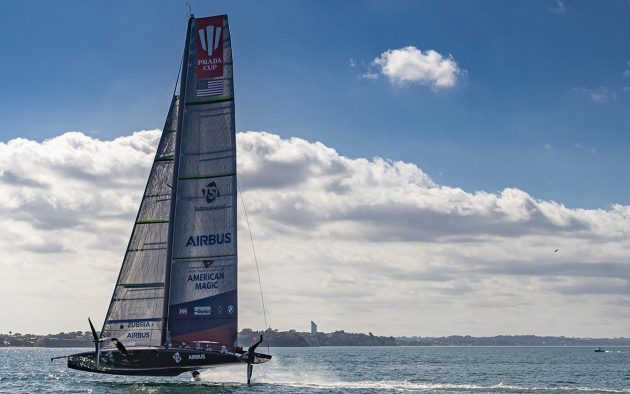
American Magic hit an impressive 53.3 knots on their final weekend of racing. Photo: COR 36/Studio Borlenghi
1 Unimaginable speed
In their final race before being knocked out of the competition , American Magic’s Patriot registered a top speed of 53.3 knots during a bear away.
Topping the 50-knot barrier used to be the preserve of extreme speed record craft and kiteboarders. A World Speed Sailing Record was set in 2009 of 51.36 knots by Alain Thebault in his early foiling trimaran, Hydroptere , and was bested in 2010 by kite boarder, Alexandre Caizergues who managed 54.10 knots.
O nly one craft has ever topped 60-knots, the asymmetric Vestas Sail Rocket , which was designed for straight line speed only and could no more get around an America’s Cup course than cross an ocean. Such records are set by sailing an average speed over the course of 500m, usually over a perfectly straight, flat course in optimum conditions.
America’s Cup class yachts, designed to sail windward/leeward courses around marks, are now hitting speeds that just over a decade ago were the preserve of specialist record attempts, while mid-race.
Perhaps even more impressive, in the right conditions when racing we have seen some boats managing 40 knots of boatspeed upwind in around 17 knots of wind. That is simply unheard of in performance terms and almost unimaginable just three or so years ago.

Photo: COR 36/Studio Borlenghi
2 A storm onboard America’s Cup boats
Related to the speeds the boats are sailing through the water, particularly upwind, is the wind speeds the sailors will feel on deck.
When sailing, the forward motion affects the wind we experience onboard, known as apparent wind. The oft’ trotted out explanation of how apparent wind works is to imagine driving your car at 50mph. Roll down the window and stick your hand out of it and there will be 50mph of wind hitting your hand from the direction your car is travelling.
Article continues below…

America’s Cup: Schedule and how to follow the racing
The teams are there, the boats are there, and finally after two months of AC75 racing in Auckland, for the…

America’s Cup Challengers: The view from Auckland
Reversing the odds over the space of four weeks where the worst performing America’s Cup team became the best and…
So when an AC75 is sailing upwind in 18 knots of breeze at a boatspeed of 40 knots, the crew on deck will be experiencing 40 knots of wind over the decks plus a percentage of the true wind speed – depending on their angle to the wind.
The AC75 crews might be sailing in only 18 knots of breeze – what would feel like a decent summer breeze on any other boat – but they experience winds of around 50 knots.
To put that into context, that is a storm force 10 on the Beaufort scale!

Once up on the foil, everything to windward of the leeward foil generates righting moment. Photo: COR 36/Studio Borlenghi
3 Righting moment changes
The single most radical development of the AC75 is to take a 75ft ‘keelboat’, but put no keel on it whatsoever.
When the America’s Cup Defender and the Challenger of Record, Emirates Team New Zealand and Luna Rossa Prada Pirelli respectively, announced the 36th America’s Cup would be sailed in 75ft monohulls, conventional wisdom had it that the boats would look something like a TP52 or a Maxi72 – both impressively high performance keelboats.
By doing away with the keel entirely, the design is now like nothing we have ever seen, particularly when it comes to how dynamic the power transition is between foiling and not foiling.
The boats are designed to foil on the leeward foil, with the windward one raised to help increase righting moment: to help balance the boat. This means that when the AC75 is not foiling they are extremely tippy – much more so than most other boats of the same size.
Essentially, when the wind catches the sails, the boat wants to fall over as there is too much sail area for the amount of weight underneath the boat – something a lead keel usually counters on a yacht or keelboat.
Once the boat is up and on the foils, however, that all changes, as everything to windward of the single foil in the water balances the sails. That means, the hull, the crew weight, the sail and rig weight, and the windward foil, all work to counter the sails.
What all this means is that the boats go from being extremely tippy, to hugely powerful in just the few seconds it takes to get up on the foil. “The [AC75s] are really very tippy pre-foiling and then they go through the transition where they will need to build significant power. Then immediately [once they lift off] you have more stability than, well, take your pick, but certainly more righting moment than something like a Volvo 70 with a big canting keel.
“That change all happens in a very short space of time,” explained Burns Fallow of North Sails, who was one of the team who developed the soft wing concept back when the concept was revealed.

With lift created to windward by the foils, it is possible that the boats can sail diagonally to windward. Photo: COR 36/Studio Borlenghi
4 America’s Cup boats may not be heading where they point
With the AC75 sailing on its foil, drag is dramatically reduced, vast amounts of power can be generated and so speeds rapidly increase. But the foils can serve another purpose too.
In order to be able to lift each foil out of the water, the foil arms must be able to be raised and lowered. Hence the foil wings, which sit at the bottom of the foil arms (and are usually a T or Y shape), do not always sit perpendicular to the water surface and the AC75s often sail with them canted over to something nearer 45º to the surface.
The further out the leeward foil arm is canted – essentially more raised – the closer the AC75 flies to surface and, crucially, the more righting moment is generated as the hull and rest of the boat gets further from the lifting surface of the foil.
There is another positive to this: as the lifting foil is angled, it produces lift to windward, which can force the boat more towards the wind than the angle it is sailing.
Due to this negative leeway (as it is known when a foil creates lift to windward) the boat can be pointing at a compass heading of say 180º but in fact will be sailing at eg 177º as the foil pushes the boat sideways and to weather, essentially sailing to windward somewhat diagonally.

5 The foils are heavy. Very heavy.
As the foils work to provide stability to the boat (when it is stationary both foils are dropped all the way down to stop it tipping over) and to provide massive amounts of righting moment, they are incredibly heavy.
A pair of foil wings and flaps (excluding the one-design foil arm which attaches them to the boat and lifts them up and down) weigh 1842kg. To put that into perspective, the entire boat itself with all equipment (but without the crew) weighs between 6508kg and 6538kg. So the foil wings at the base of the foil arms are nearly ⅓ of the total weight of the boat.
It is partly due to this that you will see some teams with bulbs on their foils. If you decide to go for a skinny foil wing (which would be low drag and so faster) then there will not be enough volume to cram sufficient material in to make the foil weigh enough. So some teams have decided to add a bulb in order to make it weigh enough but to also keep a less draggy, slimmer foil shape.
6 Sails can invert at the head

As with everything on the AC75, the mainsail is a relatively new concept. It consists of two mainsails which are attached to both corners of a D-shaped mast tube. This has the effect of creating a profile similar to a wing.
It is well established that solid wing sails are more efficient at generating power than a soft sail and for this reason solid wings were used in both the America’s Cup in 2013 and 2017. But there are drawbacks with a wing: they cannot be lowered if something goes wrong and require a significant amount of manpower and a crane to put it on or take it off a boat.
One reason a wing makes for such a powerful sail is that the shape can be manipulated from top to bottom fairly easily with the right controls. With the AC75 the designers wanted a sail that could have some of this manipulation, produce similar power but could also be dropped while out on the water. The twin skin, ‘soft wing’ is what they came up with for this class of America’s Cup boat.
In addition to the usual sail controls, within the rules, the teams are allowed to develop systems for controlling the top 2m of the mainsail and the bottom 1.5m.
What this means is that the teams are able to manipulate their mainsail in a number of different ways to develop power and control where that power is produced in the sail. But it also means that they have the ability to invert the head of the sail.
Doing this effectively means ‘tacking’ the top of the sail while the rest of the sail is in its usual shape. The advantage here is that instead of trying to tip the boat to leeward, the very top of the sail will be trying to push the boat upright and so creating even more righting moment. The disadvantage is that it would come at the cost of increased aerodynamic drag.
We know that a number of America’s Cup teams are able to do this, though whether it is effective is another question and it is very hard to spot this technique being used while the boats are racing at lightning speeds.

Photo: Emirates Team New Zealand
7 An America’s Cup boat generates lots of data
A new America’s Cup boat is a vastly complex bit of kit. Each team has incredibly powerful Computational Fluid Dynamics (CFD) software packages and simulators in order to try to understand the various gains and losses.
To make these simulators and computer projections as accurate as possible each team has been getting as much data as they can over their three year development cycle.
In the case of this America’s Cup it does seem the development process is genuinely getting closer to Formula 1 (albeit with smaller budgets than a modern F1 team has behind them).
INEOS Team UK have been able to work alongside the all powerful Mercedes F1 team (both of who are backed by INEOS) and have been open about how much this has helped their development process. They even have some Mercedes staff out with the team in Auckland assessing their data.
“It’s really similar to F1,” explains Mercedes Applied Science Principal Engineer Thomas Batch who has 11 F1 titles to his name and is with INEOS in Auckland. “Certainly in this campaign the technology is close to what we have in F1.
“In terms of raw sensors on the boat you are probably talking in the 100s but then we take that and we make that into mass channels and additional analysis with computational versions of those channels that we then analyse and get into in more detail. So you are looking at 1000s of plots that we can delve into [per race or training session].
“That level of data analysis and then feedback with the sailors is very similar to working with an [F1] driver.”
If you enjoyed this….
Yachting World is the world’s leading magazine for bluewater cruisers and offshore sailors. Every month we have inspirational adventures and practical features to help you realise your sailing dreams. Build your knowledge with a subscription delivered to your door. See our latest offers and save at least 30% off the cover price.
- AROUND THE SAILING WORLD
- BOAT OF THE YEAR
- Email Newsletters
- Best Marine Electronics & Technology
- America’s Cup
- St. Petersburg
- Caribbean Championship
- Boating Safety

America’s Cup: 166 Years in Photos
- By Ben Meyers
- Updated: February 1, 2017
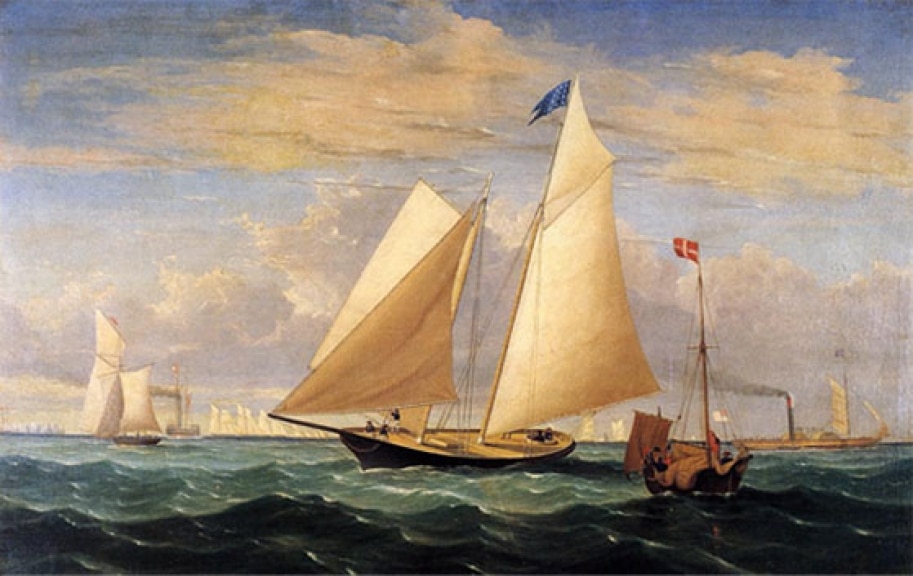
In 1851, the schooner America of New York Yacht Club sailed against 15 yachts of the Royal Yacht Squadron in the club’s annual regatta around the Isle of Wight. America finished 8 minutes ahead of the closest rival, securing victory, and beginning what would become one of the longest running competition in sports. in 1857, the Deed of Gift officially donated the America’s Cup to New York Yacht Club ensuring that it be held as a perpetual challenge trophy to promote friendly competition among nations.
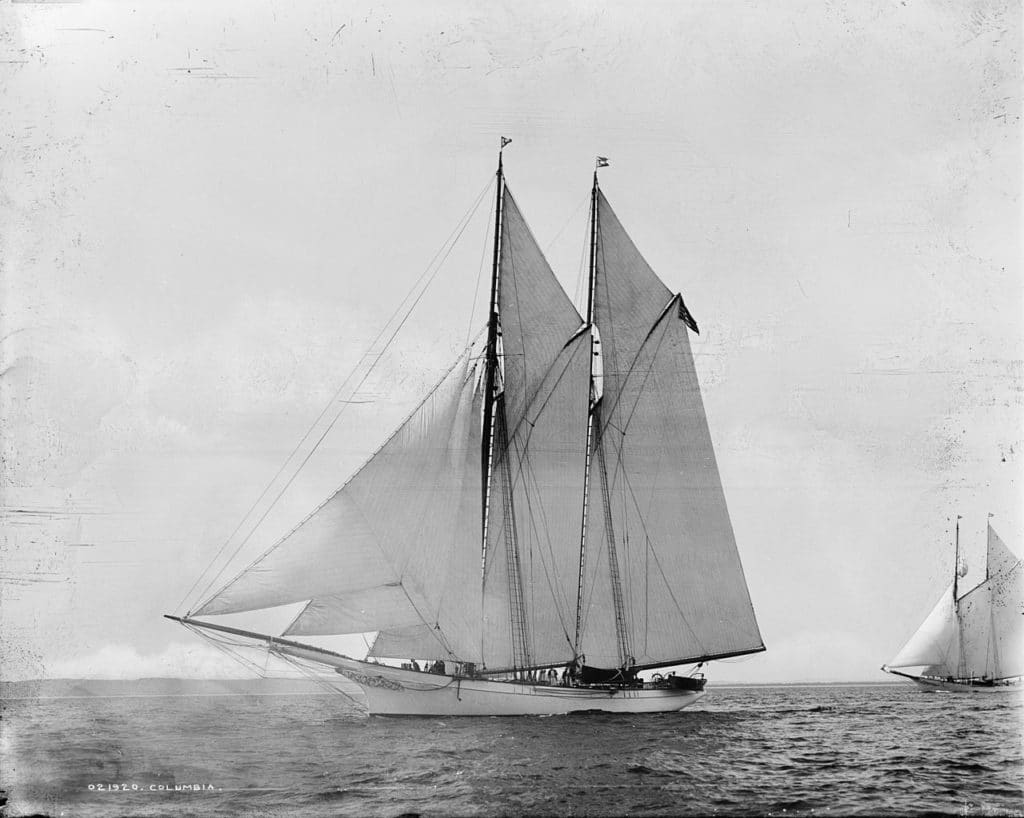
In 1871, the first official challenge to the America’s Cup came from James Lloyd Ashbury, who had previously beaten the schooner America and was emboldened by his victory. The New York Yacht Club accepted, and the schooner Columbia was chosen to defend, successfully taking the first two races before dismasting. The yacht Sappho was chosen as a replacement and continued to hold off the British challenge in the third and fourth races.
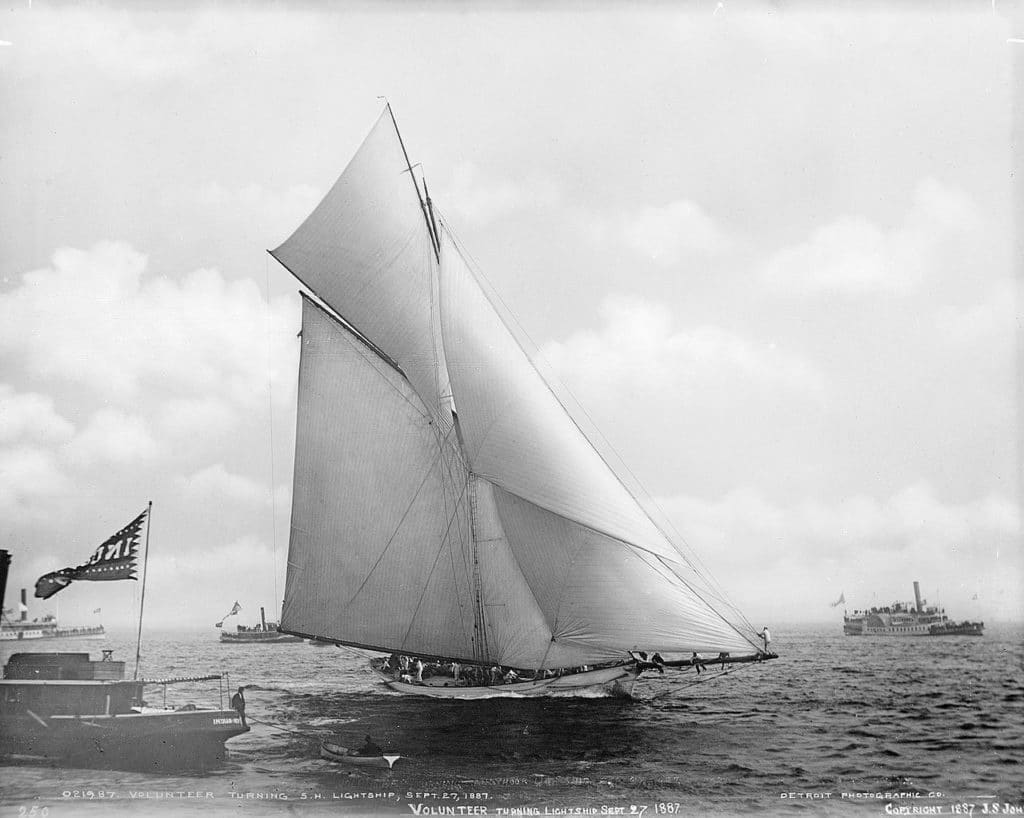
A new rule governing the design of America’s Cup yachts was drafted in 1885 after a series of Canadian challenges. Irish designer John Webb sent two yachts New York in 1885 and again in 1886 but neither could best the American designs. The final challenge under the New York Yacht Club Rule came in 1887, when Volunteer defended the Cup against the Scottish designed Thistle .
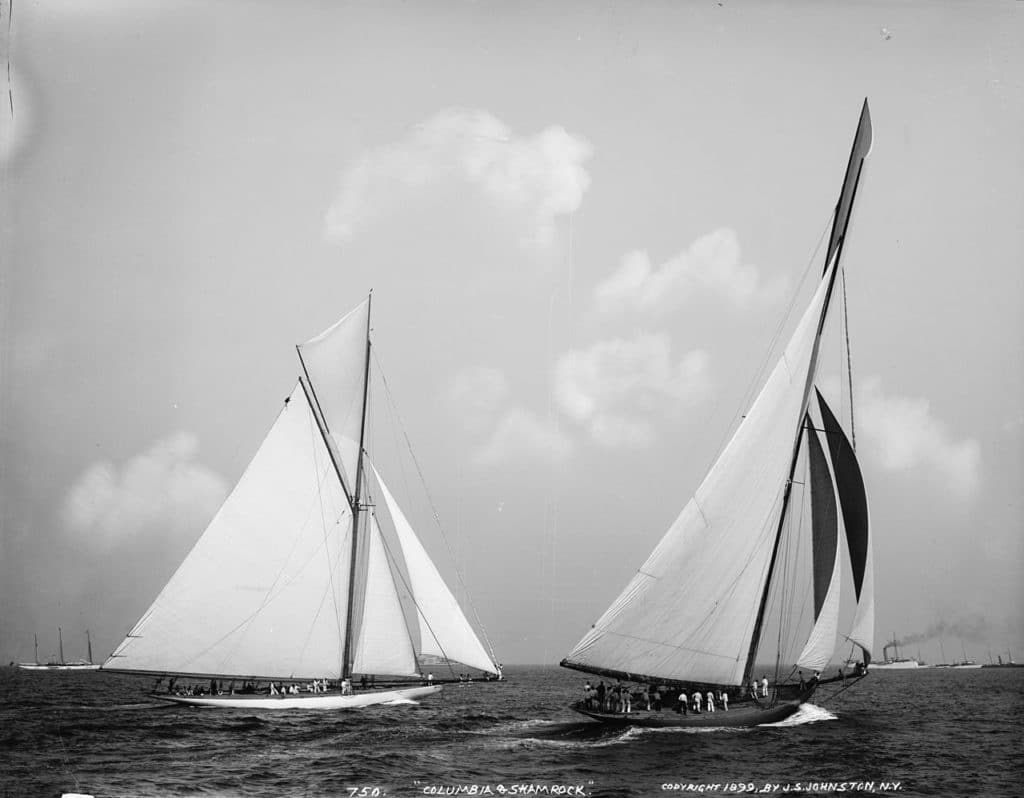
In 1889, the New York Yacht Club adopted the Seawanhaka Rating Rule. Over the next several years, Herreshoff designed boats would reign supreme, with Nathanael himself helming Vigilant to victory in 1893. In 1899, Sir James Lipton of Scotland posed the first of a series, racing Shamrock (right) against the already proven Columbia. Columbia , helmed by Charlie Barr, sailed to victory over Lipton, becoming the first yacht to defend the Cup more than once.
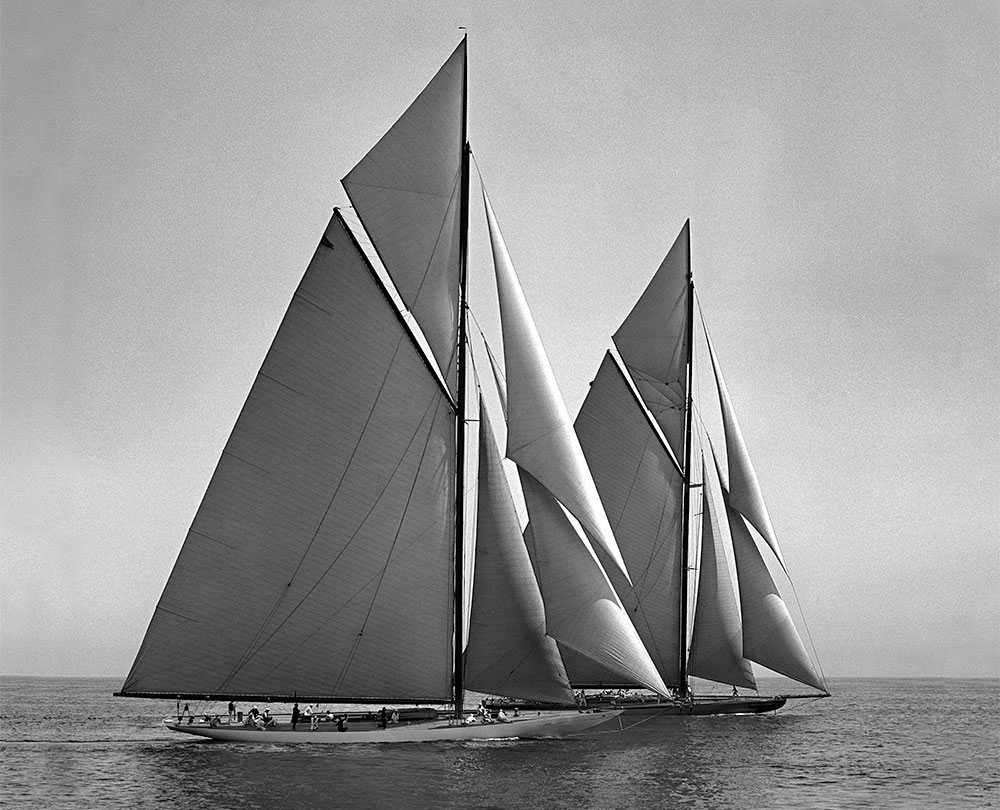
As Cup selection trials were underway for the 1914 challenge, war broke out and the Cup was cancelled, putting the first test of the newly implemented Universal Rule on hold. In 1920, the challenge resumed, with Lipton once again attempting to dethrone the Americans, this time with Shamrock IV . Lipton came the closest anyone had thus far in the event’s history to winning back the cup, winning the first two races, but the Herreshoff designed Resolute staged a comeback and went on to defend the cup for the Americans yet again.
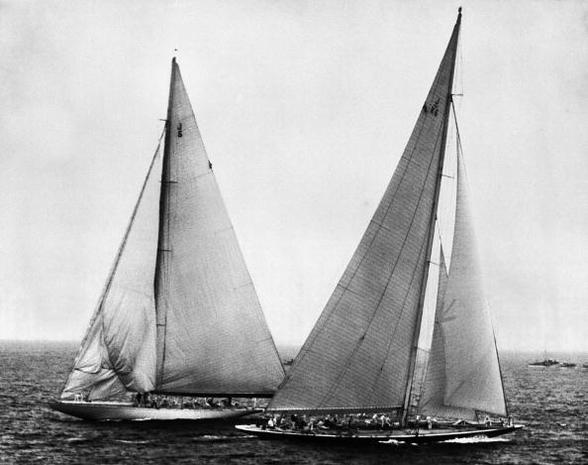
Lipton's final America's Cup challenge would come in 1929 in the J-Class. Shamrock V was heavy and outdated compared to Enterprise , which had little trouble in defeating the challenge. In 1934, having purchased Shamrock with the intent of challenging the cup, Sir Thomas Sopwith constructed Endeavor , and subsequently Endeavor II (right) for the challenge, but it was no match for Ranger (left).
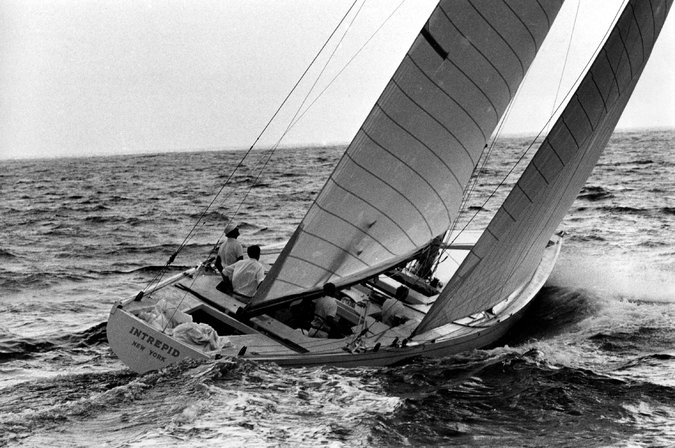
Following the second World War, the 12 Meter rule aimed to reduce the costs and ensure racing could continue in a post-war economy. The first unsuccessful challenge came in 1958, 20 years since the previous attempt by Endeavor II in the J-Class, with Columbia defeating the British challenger Sceptre . Over the next 20 years, the US would defend 7 more challenges, including the first Australian entry in 1962. Intrepid (pictured) would become just the second yacht in history to successfully defend the Cup twice, first in 1967, and again in 1970.
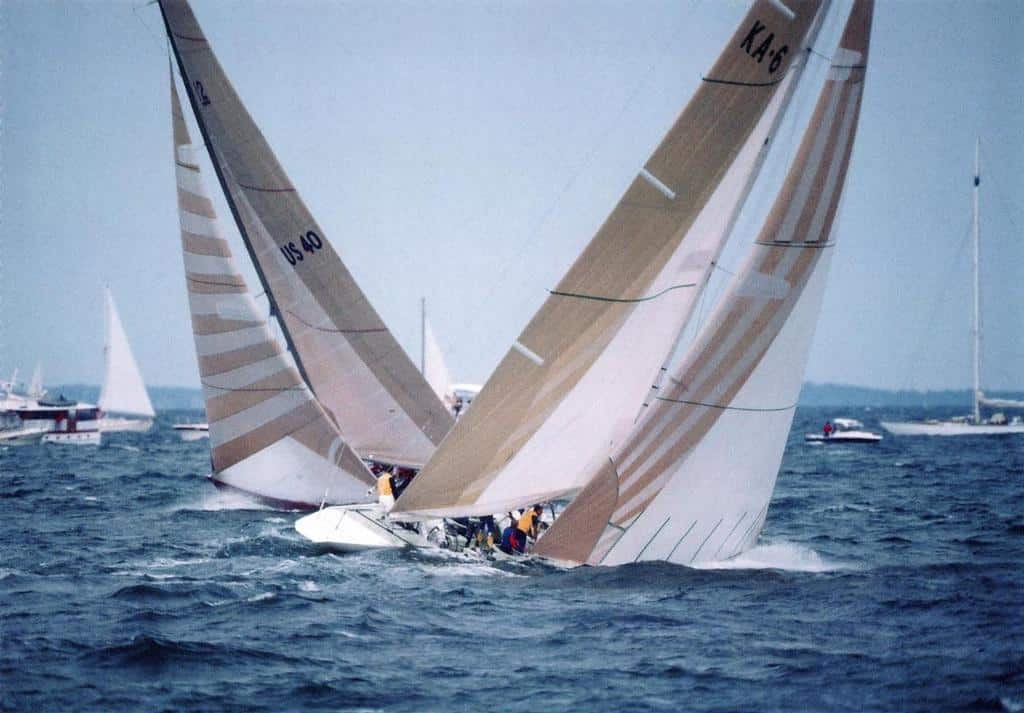
1983 would prove to be a historic and game-changing year for the history of the America's Cup. Alan Bond, who had made three attempts already at bringing the cup to Australia, returned for a fourth attempt. The design of Australia II 's (right) keel was kept secret, and in the end, the infamous winged design would prove effective. Australia II overtook Liberty , despite initial problems, and went on to upend the longest winning streak in the history of sports – 132 years.
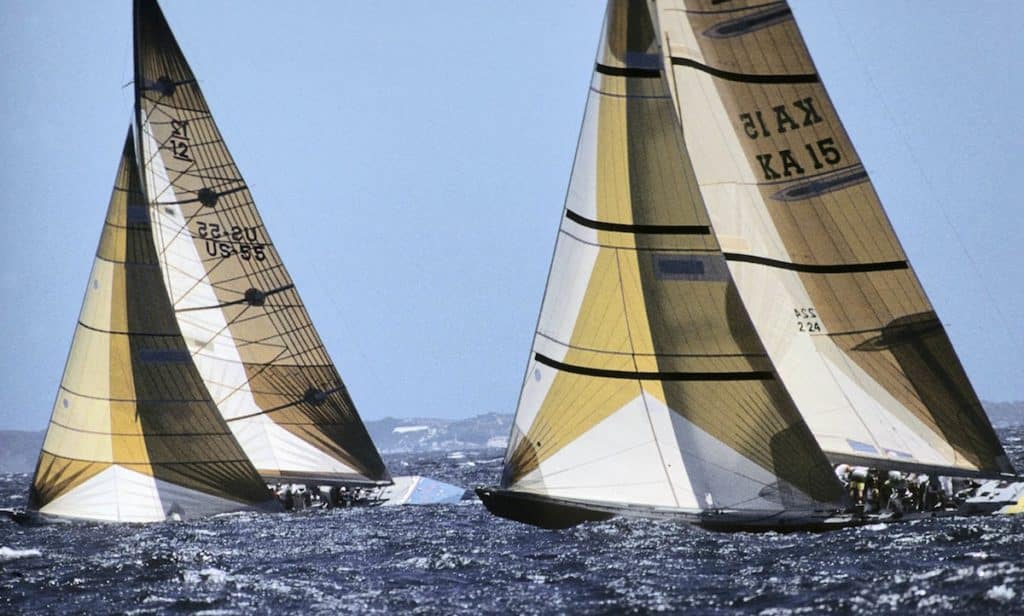
The first Cup defended outside of the United States was held in Fremantle Australia in 1987. From an unexpected field of 13 challengers, American Dennis Conner won the right to challenge the Australians through victory in the Louis Vuitton Cup. Conner easily sailed Stars & Stripes 87 to victory, beating Kookaburra III four races to zero, winning the cup back for the Americans.
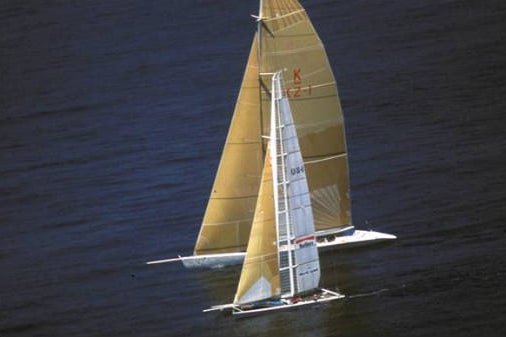
In 1988, an unexpected challenge came from a New Zealand syndicate, which proved to bring about major design changes and controversy never before seen in the America's Cup. Conner, representing San Diego Yacht Club commissioned a catamaran to respond to the Kiwi challenge, realizing that multihulls were not expressly prohibited by the Deed of Gift. New Zealand's "Big Boat" design, while cutting edge was inherently disadvantaged against Conner's catamaran and lost by a significant margin.
After the race, controversy over the legality of the design in the Deed of Gift, and whether or not the spirit of "friendly competition" had been violated was rampant. Challenger Michael Fay took San Diego Yacht Club to court over the matter and was awarded the trophy in the ruling. The decision, however, was overruled and the cup was returned to the Americans.
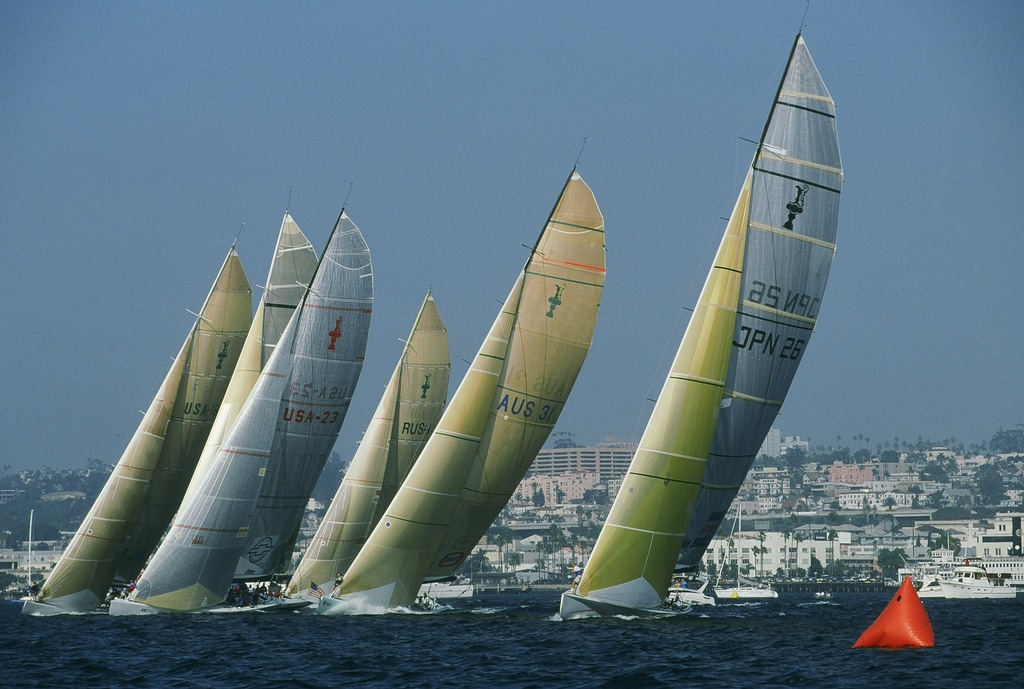
After the controversial 1988 Cup, a new design rule was put in place, and the International America's Cup Class was born. From 1992 to 2007, the Cup changed hands regularly, with strong teams fielded by Italy, New Zealand and Australia. In the 1995 Cup in San Diego (pictured), New Zealand, skippered by Russel Coutts, scored their first victory, defeating Dennis Conner 5-0.
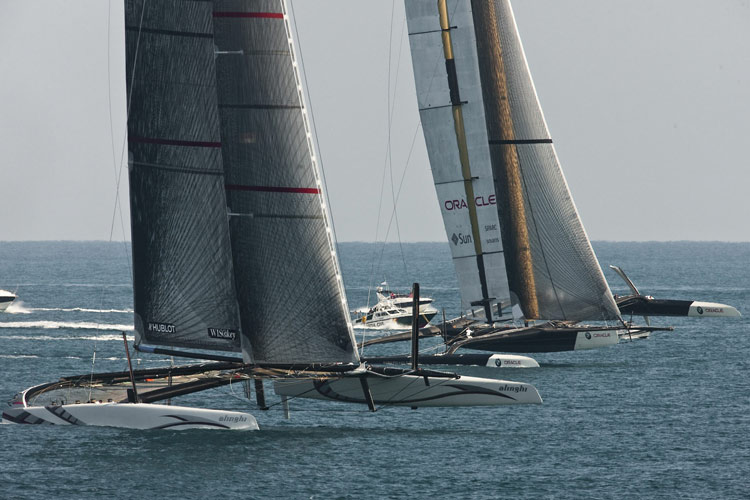
2010 brought more significant design changes to the cup, with BMW Oracle Racing challenging Alinghi in a battle of massive multihulls. BMW Oracle chose a trimaran with a rigid wing sail, similar to the sail used by Conner in the 1988 cup, while Alinghi chose traditional sails for their catamaran. The rigid wing proved to give BMW a significant advantage, and the Cup once again returned to the US.
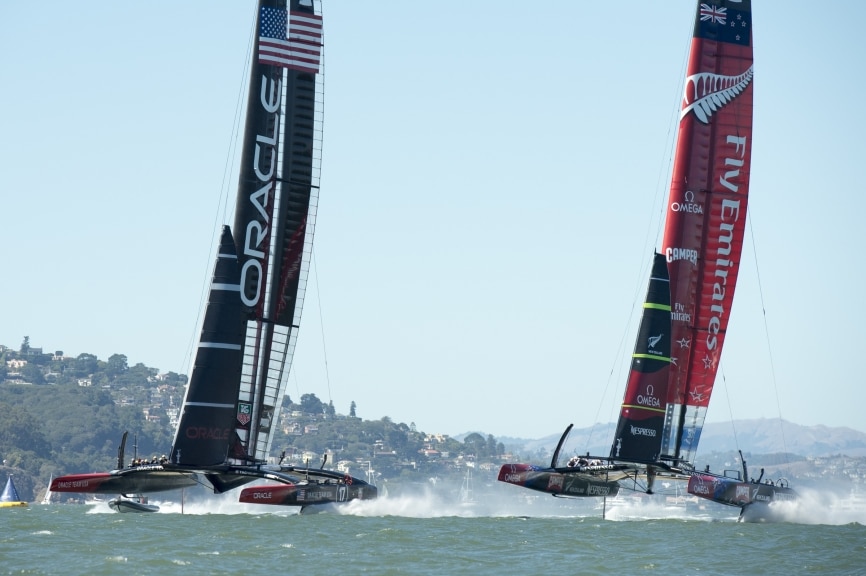
The 34th America's Cup in 2013 brought about more changes to the America's Cup class, with the defender, Oracle Team USA opting for the use of 72 foot catamarans for the racing on San Francisco Bay. The catamarans proved again to be a point of controversy over costs limiting the ability of teams to pose challenges, and the risk associated with the new, faster and more dangerous boats. Twice during training, major accidents occurred, and new safety regulations were put in place to ensure the safety of athletes.
Emirates Team New Zealand won the right to challenge Oracle in the finals, after defeating Artemis Racing and Luna Rossa in the Louis Vuitton Cup. In the final, New Zealand started strong, taking a commanding 8-1 lead, but the constant changes to crew and modifications to the boat allowed Oracle Team USA to fine tune their performance and turn the tide in their favor. In an epic comeback, Oracle overturned their 7 win deficit to beat Emirates Team New Zealand and secure the cup for America one again.
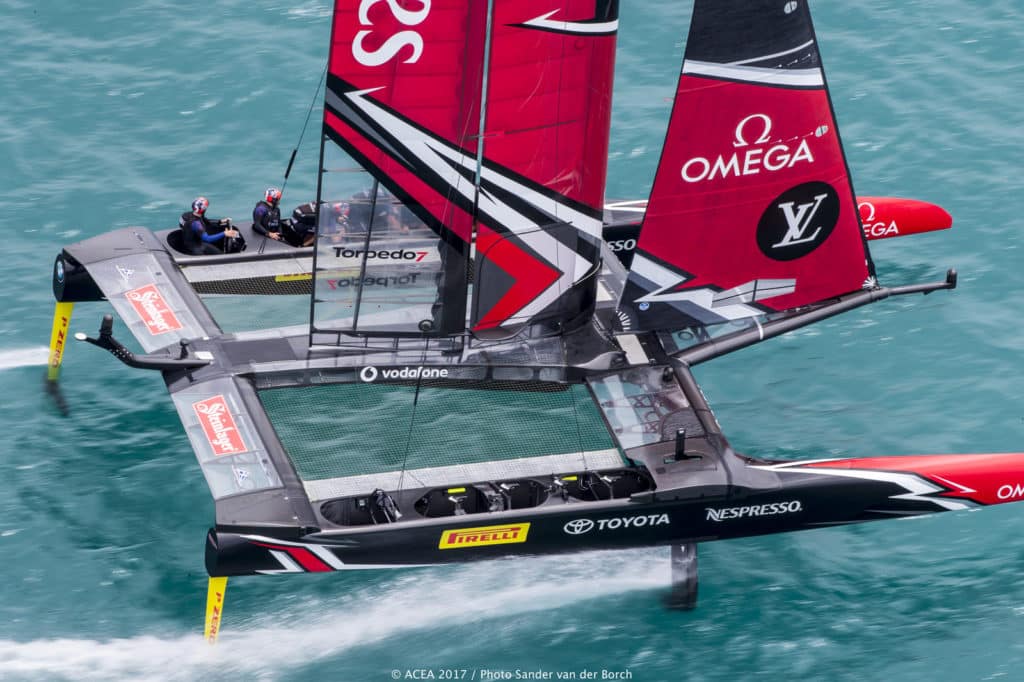
For the 35th America's Cup in Bermuda, teams agreed to cut costs and improve safety and accessibility by reducing the size of the boats to just 50 feet. Training vessels were allowed, and the AC45F, a smaller, lighter foiling catamaran was selected as the platform for the America's Cup World Series during 2016-2017. Emirates Team New Zealand dominated through Challenger Trials, facing off against Artemis in the finals for the right to challenge Oracle Team USA for the Cup.
During the Cup Finals, New Zealand proved the strength of their unique cycle-grinders, losing just one race to the Defenders in the first to seven series. The America's Cup was taken back by the Kiwis for the first time since 2000, when the Cup was challenged in Auckland.
- More: America's Cup , Americas Cup 35 , News , Sailboat Racing , Sailboats
- More Racing
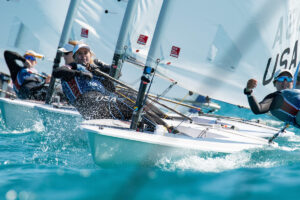
Reineke’s Battle For the Berth
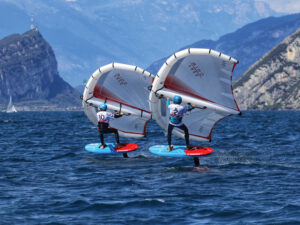
One-Design Wingfoil Racing Takes Off
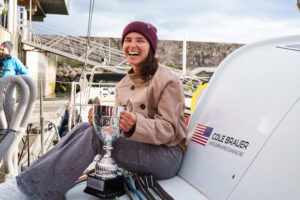
Brauer Sails into Hearts, Minds and History
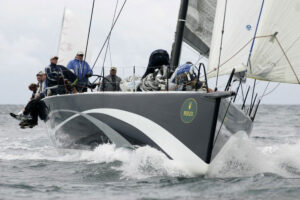
Anticipation and Temptation

America’s Offshore Couple

Jobson All-Star Juniors 2024: The Fast Generation

- Digital Edition
- Customer Service
- Privacy Policy
- Cruising World
- Sailing World
- Salt Water Sportsman
- Sport Fishing
- Wakeboarding

Number 1 America’s Cup Guide

Table of Contents
What is the America’s Cup?
The America’s Cup is a well renowned yacht racing regatta between international yacht clubs that dates back to 1851. It is the oldest competition in professional team sport and widely regarded as sailing’s most prestigious competition.
The America’s Cup has been contested 36 times with the most successful nations being the United States with 30 wins, New Zealand with three wins, Switzerland with two wins, and Australia with one win.
The current holders are the Royal New Zealand Yacht Club syndicate Emirates Team New Zealand who pulled off back to back victories in 2017 and 2021.
The next edition of the America’s Cup will be held in Barcelona, Spain in 2024.
A summary of the history of America’s Cup
The America’s Cup is the sport of yacht racing’s oldest and most prestigious competition.
It dates back to 1851 – during the reign of Britain’s Queen Victoria – making the America’s Cup trophy the oldest in international professional world sport – predating golf’s Ryder Cup, the football World Cup, and even the modern Olympics.
The competition came about after a visiting American yacht called ‘America’ – owned by a syndicate led by John Cox Stevens – won an invitational race around Britain’s Isle of Wight against a fleet of 14 of the best British racing yachts of the time.
The esteemed British yacht club the Royal Yacht Squadron awarded the victorious syndicate of American owners – all members of the New York Yacht Club – a trophy called the 100 Pound Cup (also sometimes referred to as the 100 Guinea Cup).
Six years later in 1857 the America’s owners permanently donated the trophy to the New York Yacht Club on the provision that it be renamed the America’s Cup and be awarded to the winner of a new perpetual international competition between yacht clubs.
Under the rules stipulated by America’s owners – known as the Deed of Gift – any yacht club meeting a strict set of requirements could challenge the incumbent yacht club to a race for the trophy – with the winner taking over its stewardship.
The first challenge did not come until 1870 when British railway James Lloyd Ashbury entered his schooner Cambria in the New York Yacht Club’s Queen’s Cup race in New York city on August 8 against America and a fleet of 17 American schooners.
The race was won by the American yacht Magic owned by Franklin Osgood and in doing so completed the United States’ first defence of the America’s Cup.
In the 171 years since the yacht America won the 100 Pound Cup in 1851 35 more editions of the America’s Cup have been contested.
The United States dominated the competition until the 25th edition in 1983 when the American’s 132-year winning streak – the longest in sporting history – finally came to an end when the Royal Perth Yacht Club’s yacht Australia II (skippered by John Bertrand) defeated the USA’s Liberty (skippered by Denis in Newport, Rhode Island.
The most recent edition of the AC took place in 2021 in Auckland, New Zealand when the Royal New Zealand Yacht Club’s Emirates Team New Zealand syndicate defeated the Italian yacht club Circolo della Vela Sicilia’s Luna Rossa Prada Pirelli.
The 37th America’s Cup is scheduled to take place in September – October 2024 in Barcelona, Spain when Emirates Team New Zealand will try to retain the trophy for a record breaking third consecutive time against challengers from Great Britain, Italy, Switzerland, and the United States.
How does the America’s Cup work?
Although early editions of the America’s Cup involved fleet racing the event is best known as a match racing competition where just two yachts race against each other one-on-one.
America’s Cup rating rules
The AC has adopted several different rating rules over the years to try to meet the challenge of fairly matching differently-sized yachts against each other.
New York Yacht Club Rule
The New York Yacht Club Rule was used from 1885 to 1887. It factored in waterline length and sail area and penalised yachts with waterlines over 85 feet (25.91 metres).
Seawanhaka Rule
The Seawanhaka Rule was in force from 1889 to 1903 and saw a steady increase in boat sizes. This trend culminated in the American yacht Reliance which was designed by Nathanael Herreshoff and launched in 1903 and at 201 feet (61.2 metres) overall was the largest America’s Cup yacht ever built.
Universal Rule
The Universal Rule – in force from 1914 through to 1937 – was created by Herreshoff and spawned the creation of the fast and powerful J Class yachts that many regard as the most beautiful of all America’s Cup designs.
Twelve Metre Rule
After a 19 year hiatus due to World War II the America’s Cup finally resumed again in 1956 With the J Class viewed as too expensive a design for post war times, the more cost effective Twelve Metre Rule was introduced and stayed in force until 1987.
Mercury Bay Yacht Club
In 1988, a surprise Deed of Gift challenge from New Zealand’s Mercury Bay Yacht Club based on a 90-foot (27.4 metres) monohull caught the Cup holders San Diego Yacht Club somewhat unawares. After a judge ruled the challenge was valid the Americans designed and built a state-of-the-art 60-foot (18-metre) wingsail catamaran with which they easily defended the Cup.

International America’s Cup Class
To avoid the mismatch scenario of 1988 the International America’s Cup Class (IACC) was introduced in 1992. This rule resulted in large (82-foot / 25 metre) technologically advanced boats with huge sail plans. The rule prevailed until 2007 and for many observers is synonymous with the start of the America’s Cup’s ‘modern era’.
Golden Gate Yacht Club
A second Deed of Gift match took place in 2010 when – after a protracted court case – the United States’ Golden Gate Yacht Club’s BMW Oracle Racing faced off against the Swiss Cup holders Alinghi in two giant multihulls in Valencia, Spain. After long delays for the right wind conditions the American’s wingsail trimaran proved too fast for the Swiss to take the series two races to zero.
AC72 and AC50 Catamaran Rules
2103 saw a new multihull rule introduced and the advent of the spectacular AC72 foiling catamarans. Although the rule was not originally intended to allow for flying boats it also did not prohibit them. When images emerged in the run up to the Cup of the New Zealand team successfully foiling the other teams had to scramble to respond.
The following edition of the America’s Cup in 2017 was raced in smaller but quicker five person foiling catamarans known as the AC50.

Introduced in 2021 the AC75 Class was a radical departure from anything the America’s Cup had seen before featuring 75-foot (23 metre) foiling monohull yachts. These super complex and difficult to sail yachts are the fastest craft in America’s Cup history and reach peak speeds of over 50 knots.
How many countries have won the America’s Cup?
The United States is the most successful country in the America’s Cup having won it 25 times in a row between 1851 and 1980 and then again five more times in 1987, 1988, 1992, 2010 and 2013.
New Zealand is the next most successful country with three wins in 2000, 2017 and 2021.
Switzerland has won the America’s Cup twice: in 2003 and 2007.
Australia won the America’s Cup in 1983 becoming the first country other than the United States to do so in 132 years.
List of countries that have won the America’s Cup:
United States 30 New Zealand 3 Switzerland 2 Australia 1

Has Great Britain ever won the America’s Cup?
Great Britain has never won the America’s Cup – despite challenging 22 times – in 1899, 1901, 1903, 1920, 1930, 1934, 1937, 1958, 1964, 1980, 1983, 1987, 2003, 2017, 2021.
Who is the most successful America’s Cup skipper?
American yachtsman Dennis Conner is arguably the best known skipper in the America’s Cup but he shares his three victory record with two other skippers – New Zealand yachtsman Russell Coutts and British skipper Charlie Barr.
Dennis Conner won the America’s Cup in 1980, 1987, and 1988.
But he is also renowned for in 1983 becoming the first American skipper to lose the Cup after 132 years of US domination when his stars and Stripes campaign was defeated by John Bertrand’s Australian crew on Australia II.
Russell Coutts won the America’s Cup as a skipper in 1995, 2000, and 2003 and was unbeaten in 14 consecutive races across those victories.
British skipper Charlie Barr won the America’s Cup three times – in 1899, 1901, and 1903 – sailing for American owners on each occasion and with a 9 to zero win loss record across the three editions.
Australian/American sailor Jimmy Spithill is a two-time America’s Cup winner, having in 2010 – at age 30 – become the then youngest ever winning America’s Cup skipper, before winning the next edition in 2013 when he staged a spectacular comeback in which he won eight consecutive races to defend the Cup nine points to eight.
New Zealand Olympic silver and gold medallist Peter Burling has won the America’s Cup twice. His first victory was in 2017, when at age 26 he became the youngest ever America’s Cup winning skipper. His second America’s Cup win was in 2021.

Who won the last America’s Cup?
Emirates Team New Zealand representing the Royal New Zealand Yacht Club won the 37th America’s Cup which took place in Auckland, New Zealand in 2021.
The New Zealand syndicate defeated the Italian yacht club Circolo della Vela Sicilia’s Luna Rossa Prada Pirelli.
When is the next America’s Cup?
The next edition – America’s Cup 37 – is scheduled to take place in September and October of 2024 in the Spanish city of Barcelona.
More information on the America’s Cup:
America’s Cup website
Cup Insider website
America’s Cup story archive on Yacht Racing Life

Building on success
Doyle Sails builds on success with a renewed focus on next-level R&D. A stellar showing at the 2023 Maxi World Championships might have been just cause for celebration at Doyle Sails. Instead, the mood of quiet satisfaction was eclipsed by a determination to keep focused on pushing the technology, design and development of high-performance sails…

Life forward of the beam
The new generation of large, high-performance luxury cruising catamarans are making great use of the latest developments in AC rig technology. You simply can’t miss them, big cats on the prowl. Their numbers have exploded in recent years as the market for luxury multihulls grows by the season. But this is far more than the…

53 Trofeo Princesa Sofía Mallorca set to showcase Olympic classes
With the first entry registration period now closed, most of the racers who will compete at the 53 Trofeo Princesa Sofía Mallorca by Iberostar have already registered. With just under a month to go until the first start guns on the Bay of Palma, nearly 800 teams have applied to compete in the showcase, curtain…

Clarisse Crémer and Tanguy Le Turquais cleared of misconduct by international jury
French yachtswoman Clarisse Crémer and her husband Tanguy Le Turquais have been cleared of anonymous allegations of cheating during the last edition of the Vendée Globe singlehanded non-stop around-the-world race. The ruling handed down by an international jury convened by the Vendée Globe organisers followed an independent investigation into the couple’s WhatsApp messages while Crémer…

Shirley Robertson takes over as manager of the Super Yacht Racing Association
The Super Yacht Racing Association (SYRA) as announced Shirley Robertson as the new manager of the association. With a wealth of experience and success in the sport and a notable presence in superyacht racing, Robertson brings a valuable perspective and new energy to the SYRA. Shirley Robertson OBE made history by becoming the first British…

470 World Championship – Xammar and Brugman reign in Spain
Jordi Xammar and Nora Brugman (ESP) have been crowned 470 World Champions of 2024. After five days of competition in a variety of conditions on the Bay of Palma, the stormy conditions of Sunday meant no Medal Race to conclude the 470 World Championship in Mallorca. The Spanish team would have taken an 11-point advantage…

America’s Cup: Changing gear
Just as teams were getting used to the heat of competition and squaring up to their opponents at the two America’s Cup Preliminary Events, the Cup programme sees no further racing until mid-August. In addition, the rules of the event as published in the AC37 Protocol prohibit teams from arranging informal racing between each other…

Offshore legend
This month on Shirley Robertson’s Sailing Podcast Shirley talks to British offshore adventurer Pete Goss, an accomplished offshore sailor famed for executing one of the bravest solo ocean rescues of all time. Talking at his home in the south west corner of the UK, Robertson and Goss kick their discussion off with chat about his…

Charles Caudrelier wins inaugural Ultim solo around the world race
French solo racer Charles Caudrelier, skipper of the Maxi Edmond de Rothschild crossed the finish line off the coast of Brest, this Tuesday morning at 8h 37m 42s local time (UTC+1hrs) to win the Arkea Ultim Challenge Brest, the first ever solo multihulls race around the world, sailed in giant 32m long Ultim class trimarans….

Victory on home waters marks first Australian win of SailGP Season 4
Tom Slingsby and his Australian crew have been crowned champions of the KPMG Australia Sail Grand Prix | Sydney, flying home in front of an ecstatic and vibrant ‘Genesis Island’ crowd and a jam-packed Sydney Harbour to clinch the sensational win from Denmark and New Zealand in the three-boat final. With the home crowd cheering…

SailGP: Danes and Australians top the leaderboard on opening day in Sydney
Tom Slingsby and his Australian crew have delivered for the home crowd at the opener of the KPMG Australia Sail Grand Prix, securing a solid second place but on equal points with Nicolai Sehested’s ROCKWOOL Denmark, who takes the top spot in a thrilling showdown on Sydney Harbour. After a light-wind season to date, fans…


Ten teams ready to race in Sydney
With just one day remaining until the highly awaited KPMG Australia Sail Grand Prix takes place on the picturesque waters of Sydney Harbour, anticipation builds across the fleet as the most exciting racing on water looks set to live up to its name as the teams get ready for a record fifth appearance down under,…

Storm Louis delays Caudrelier’s victory parade
Arkea Ultim Challenge race leader Charles Caudrelier and the ULTIM Maxi Edmond de Rothschild have been in the Azores port of Horta since Wednesday morning waiting for storm Louis to leave the Bay of Biscay and a weather window to open to allow him to complete the final 1200 miles of the 24,400 nautical miles…

Sustainable future
Lifecycle assessment was the important first step in Southern Wind’s drive to reduce their carbon footprint. Now they’re making positive changes. ‘Sustainability is moving away from being a fashion or a passion, to being almost business as usual. If we don’t go in this direction we won’t be in business in five or 10 years.’…

An intriguing new chapter in the 470’s Olympic history
It’s just over a week until the 470 World Championship begins in Palma, Mallorca. Taking place from 24 February to 3 March, 63 international teams are making final preparations before one of the most important regattas of their careers. For a number of teams the Bay of Palma offers an opportunity to earn selection for…

Rudder damage forces second Brazilan stop for Le Cléac’h
In a message distributed late this morning, the Banque Populaire team has confirmed that Armel Le Cléac’h’s ULTIM Maxi Banque Populaire XI, racing in second place on the Arkea Ultim Challenge around the world race, has suffered damage to the central rudder after an incident. According to the team, several options are being studied to…

Clarisse Crémer refutes Vendée Globe cheating accusations
A story published by France’s international news agency Agence France-Presse (AFP) has named French yachtswoman Clarisse Crémer as the Vendée Globe skipper accused of cheating in the 2020-21 edition of the high profile solo non-stop around the world sailing race. Crémer is quoted as vehemently denying the accusation in a joint statement she issued with…

Upwind by MerConcept female high-performance multihull racing program launched
MerConcept, the high-performance hub for offshore sailing and sustainable technologies based in Concarneau, France, has announced the launch of its brand-new racing program to provide female sailors with experience in offshore multihull racing. UpWind by MerConcept will recruit, train, and support a squad of six female sailors as they compete in the Ocean Fifty offshore…
The Evolution of Yachting at The America’s Cup Finals
From sir thomas lipton’s shamrock v to the newly launched svea, the 35th edition of the america’s cup is bringing together the biggest fleet in the history of the j class to race in the waters off bermuda..
The evolution of yachting will be televised this year—the hydro foiling cats will be bombing around the cans and the J-Class, which competed for the cup throughout the 1930’s, will bring back the spirit of the one design class challenging for the ‘Chart’.
The original winner of The America’s Cup in 1851, “America”, was the boat that gave the trophy its name. It was a 101 foot monohull schooner which carried over 5,400 square feet of sail, and the golden years of the Cup with the J’s.
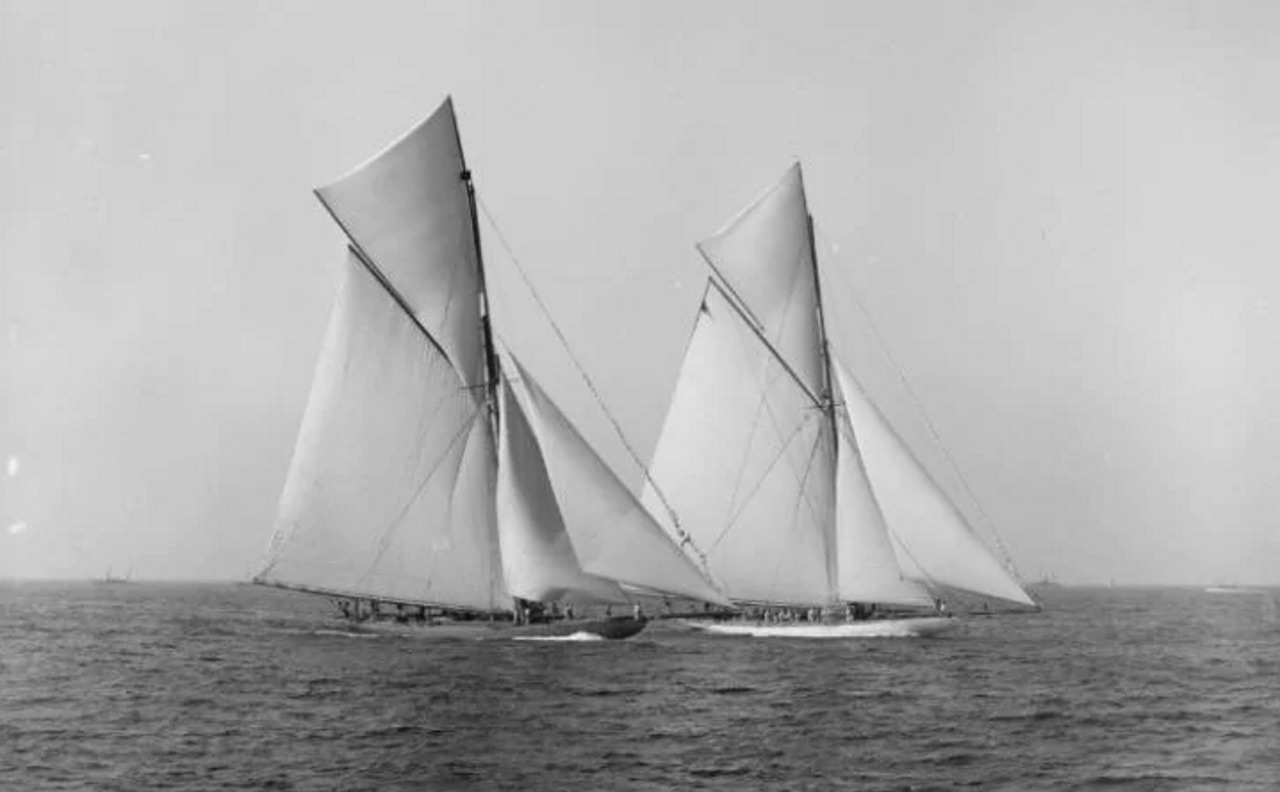
Technology and development has been a big part of the America’s Cup since the beginning—and this year’s cup is no different as teams search for any advantage to get that extra knot of speed.
In terms of evolution, the boats themselves are controversial, yet innovative, changing the AC Class of boat by two-folds.
[gallery type="rectangular" size="full" ids="8339,8341"]
In contrast is the America’s Cup Class, a 50 foot long carbon fibre catamaran featuring a wingsail and hydrofoiling technology that enables the boats to fly above the water. This is achieved by the boat being lifted above the water by a carbon fibre fin about the size of a 5’2 fish known as a foil. As the boat speeds up, they lift out of the water.
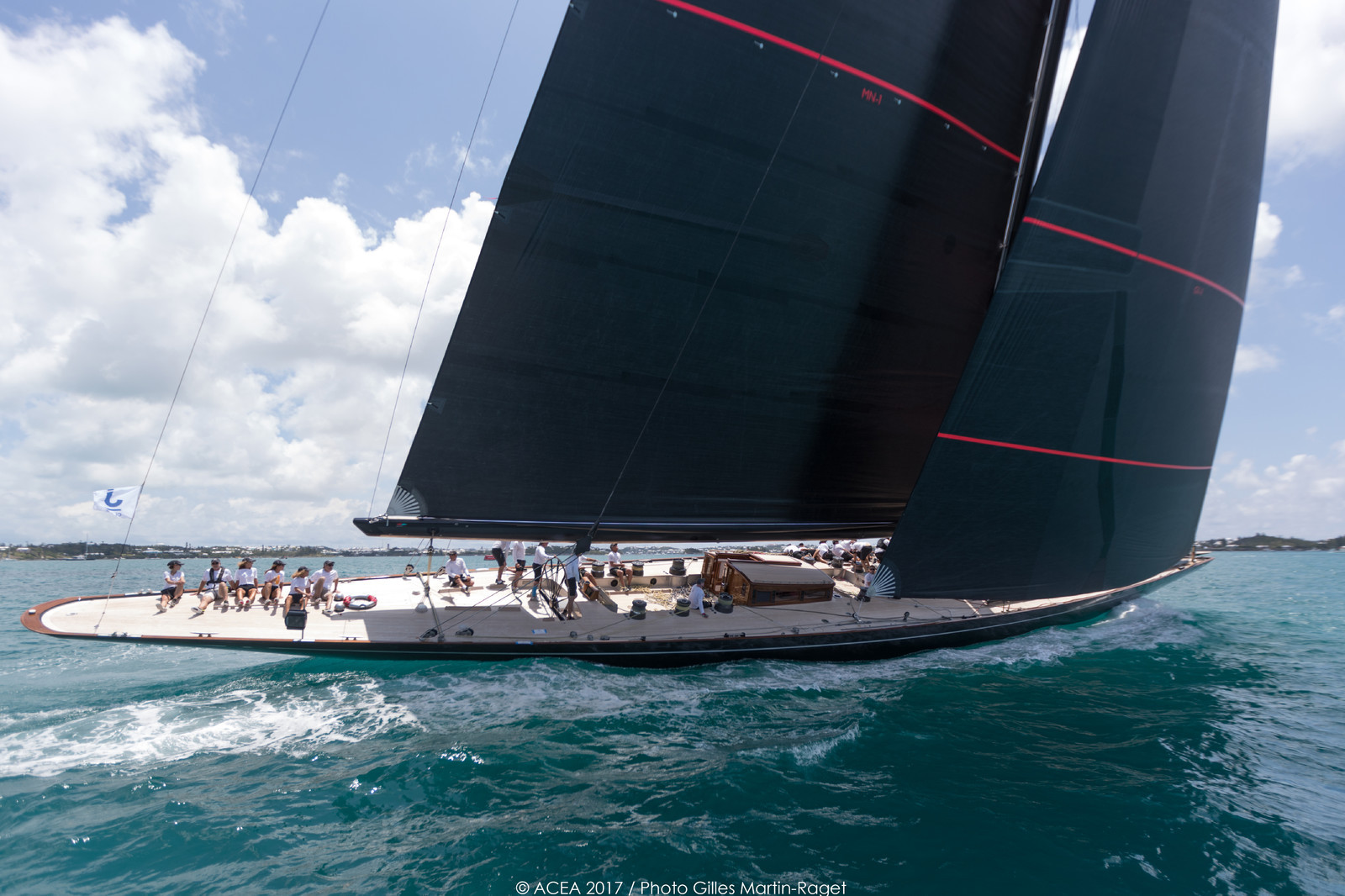
Using the lift generated by the daggerboards and rudders, the game is to keep the hull above the water line, sailing on a set of carbon-fiber foils that give enough lift to have the boat looking at fly time hitting speeds of up to 50 knots, which has come a long way from the Schooner America, the J Class and the monohulls of the 80’s and 90’s.
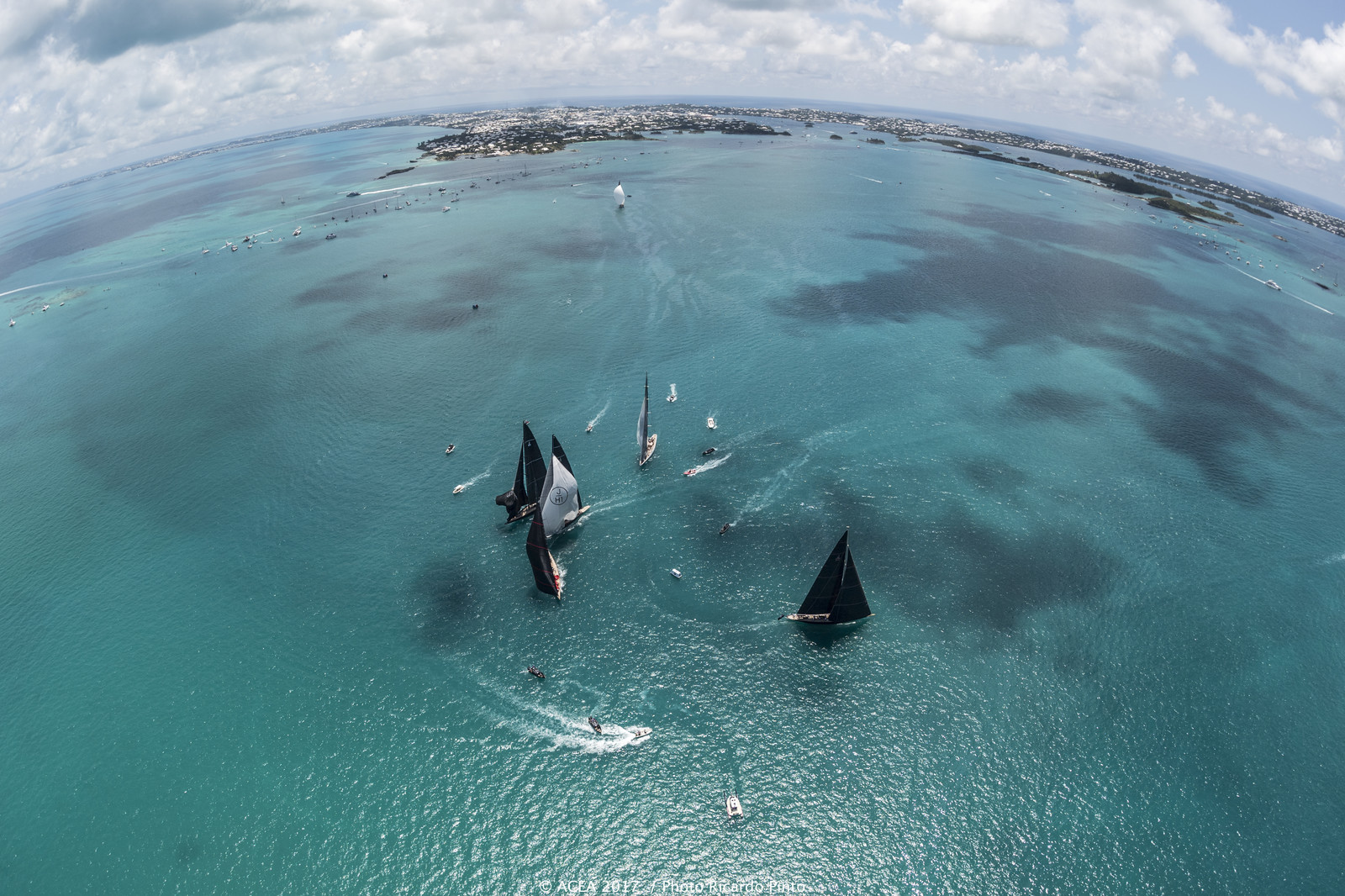
The clear waters of Bermuda will have an evolution that, in design, has changed, but with the tactics remaining the same. From the J’s to the AC’s, we are looking at a month’s sailing that for the spectator, professional and novice alike, will showcase an ocean of history in the water.
With the contest for the cup already begun, the challengers have been fighting it out in a one-on-one knockout series of sailing, with it coming down to the playoffs final with Emirates Team New Zealand and ‘The Swedes’ Artemis racing, with helmsman Peter Burling’s Emirates coming out on top.
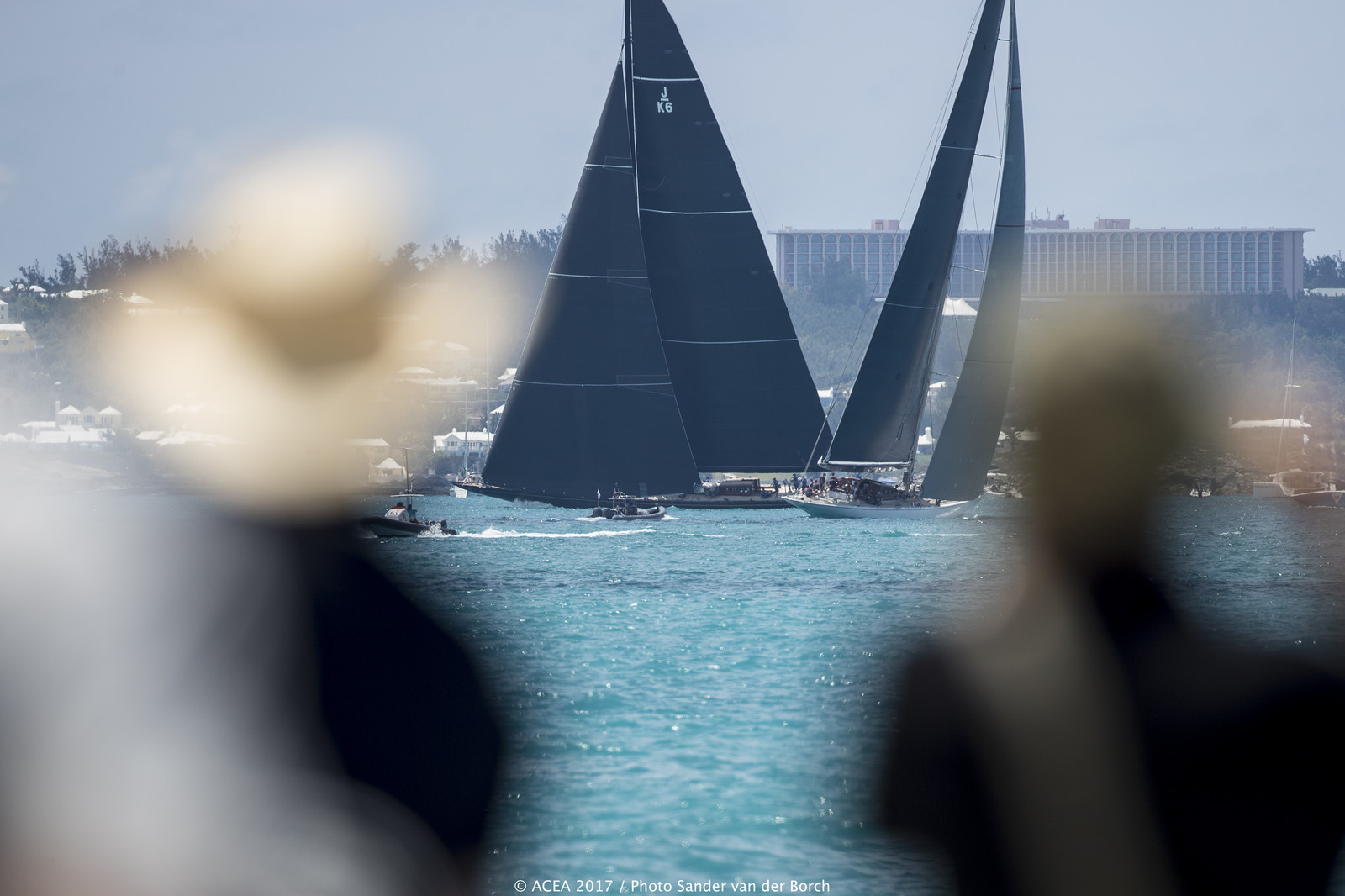
The teams are now challenging for the oldest trophy in sport, with the team to beat being cup holders ‘the’ Oracle Team USA.
The next days of sailing are going to be epic!
The next round of races take place June 24th-27th and The Outdoor Journal is on the island and in the sheds to bring you some of the action from the water, with updates on the boats and a bit of behind the scenes beers and discussions of the days racing with the captains and crews. Stay tuned!
35th Americas Cup - The Finals: Oracle Team USA the holders Emirates Team New Zealand the challengers
Americas Cup J Class Regatta The line-up for the J’s is an amazing 7 boats, Being the biggest fleets of boats in the history of the class.
JK3 Shamrock V 1930 JK7 Velsheda 1933 J5 Ranger 2004 JK6 Hanuman 2009 JH1 Lionheart 2010 J8 Topaz 2015 JS1 Svea 2016
For more information, head to the America's Cup website .
Feature image by Ricardo Pinto / America's Cup Match
Hon Hon Hon! French Gang Twirl Their Moustaches While Climbing Nuptse South Face
First (solo) ascent of nangpai gosum ii by jost kobusch, eoft is back with 7 of the year’s best adventure films.
RANGER – THE ‘SUPER J’
Contractionary policies in response to what was an era of recession globally, leading to reduced aggregate demand and the fundamental cause of the Great Recession were hardly conducive conditions for the building of large race yachts.
It was thought that the J-Class could well sound the death-knell for the America’s Cup as a sporting contest and even the New York Yacht Club members, often insulated to a degree from the worst of the depression, were sailing smaller boats for club racing – most notably those rating to the 12-Metre and K-Class rules.
Against this dire economic backdrop, that incidentally was about to get worse through 1937-1938 before it got better, the Commodore of the Royal London Yacht Club, Richard Fairey, entered a speculative challenge - after surreptitious enquiries had been made - with a design that measured to the lower end waterline length permitted by the Deed of Gift and measure to the 65 feet New York Yacht Club rating rule. Not unreasonably, Fairey argued in a communication to Junius Morgan, Commodore of the NYYC, that: “I feel very strongly that the present J-Class boats are altogether too large and too expensive and that their design has been overshadowed by the necessity of fitting them out with accommodation for the owner and his guests when living aboard.” Further concerns surrounded the safety of the J-Class and whether they were suitable in anything above a Force 3 with particular note around the new duralumin rigs and their seaworthiness. The New York Yacht Club, however, were not in the mood to compromise on their premier competition.
Recognising this unwillingness and the rejection of the Royal London Yacht Club’s challenge, Thomas Sopwith commissioned Camper & Nicholson of Gosport to build what was hoped to be another technical wonder, Endeavour II, that was laid down in February 1936 and launched on 8th June 1936. Its flag was to the Royal Yacht Squadron but at the time of launch, no formal challenge had been proposed as both Charles Earnest Nicholson, the boat’s designer, and Sopwith felt that a long period of working up and crew training would be the key to a successful challenge. That challenge was duly posted to the NYYC by August 1936 for the Endeavour II rating to the 76-foot rating rule as recognised by America’s premier club and seeking for racing to start in July 1937.
Early assessment of Endeavour II was mired by the collapse of two masts, but the Americans were concerned by the seemingly devastating performance of the boat against Endeavour I in light airs, where it was widely assumed that she had a significant advantage over the successful defender of 1934, Rainbow. The New York Yacht Club formed a syndicate again under the command of Harold ‘Mike’ Vanderbilt who duly commissioned Starling Burgess as lead designer but also made the crucial decision to create a design team by bringing onboard the fast-rising star of yacht design in Olin J. Stephens. Burgess’s star had been falling for a while in the eyes of the members of the New York Yacht Club with the view, widely expressed, that the speed deficiencies of Rainbow and Enterprise were only rectified by the brilliance of Vanderbilt, Bliss and Hoyt in the afterguard. Bringing Olin Stephens in was a nod to the future and a check on Starling Burgess.
Tank-testing was nothing new in the America’s Cup, G.L Watson was tank-testing in 1900, but the advance in the way those tests were undertaken, and the data extracted, particularly in terms of heel angle and side force, saw the 1937 design project for Ranger advance yacht design to a whole other scale. Using the Stevens Institute testing tank at Hoboken under the command of Professor Ken Davidson, Stephens and Burgess both drew lines for two models each to be tested. The final design for Ranger has, however, become something of legend with no clear view on whether it was from the hand of Burgess or Stephens as the models were adapted during testing with input from both, but what became evident was that the result was a sensation.
Olin’s brother, Rod Stephens, was brought in for the design of the rig whilst Starling’s brother, Charles Burgess, took charge of the mast design. These were crucial areas as Vanderbilt insisted on using some sails from the Rainbow campaign – in particular an unused mainsail that he had been saving – and much concentration was given to more efficient sail-handling. Meanwhile, the final design for Ranger’s hull profile had the mark of Olin Stephens writ large with a low aft profile and the famous snub-nosed bow whilst Vanderbilt himself had considerable input in the final waterline length of 87 feet having seen a marked improvement in 1936 when he added a 10-ton lead shoe to Rainbow’s keel for the annual New York Yacht Club cruise races.
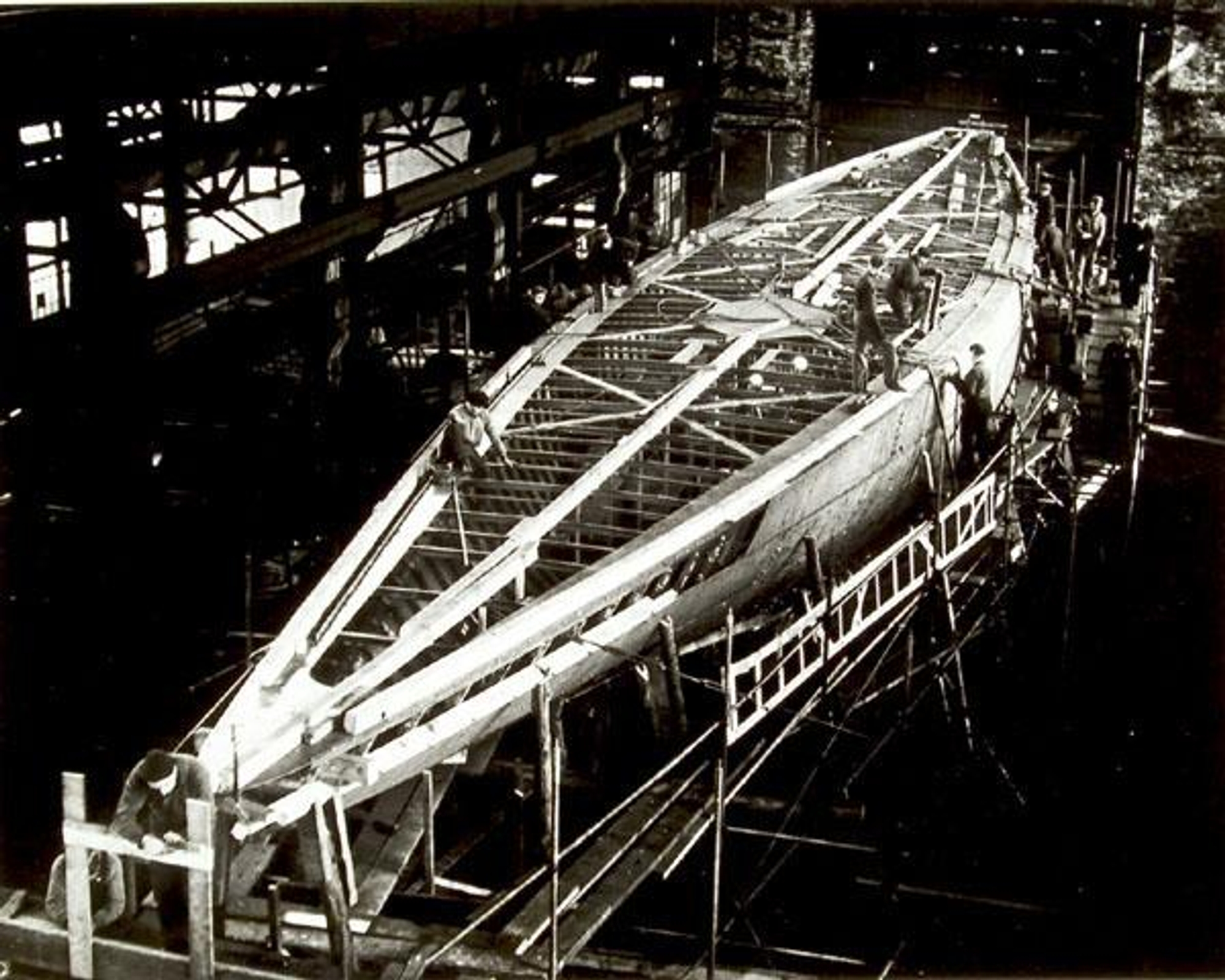
The final model that produced the design was number 77-C, one of the first tested, and the Bath Iron Works Boatyard was commissioned for the build, but worsening economic climes caused Ranger to be built at cost using highly efficient construction methods. Filler was almost eliminated in the process with flush riveted steel plating forming the hull and cedar was laid on steel for the decks to reduce both weight and cost. The designers went novel for the rudder creating a negative buoyancy structure with a watertight air compartment and a very low clearance to the hull and Ranger was launched on May 11th, 1937, after a christening ceremony with Mrs Gertrude Lewis Vanderbilt (nee Conway) breaking the customary champagne on the snub bow.
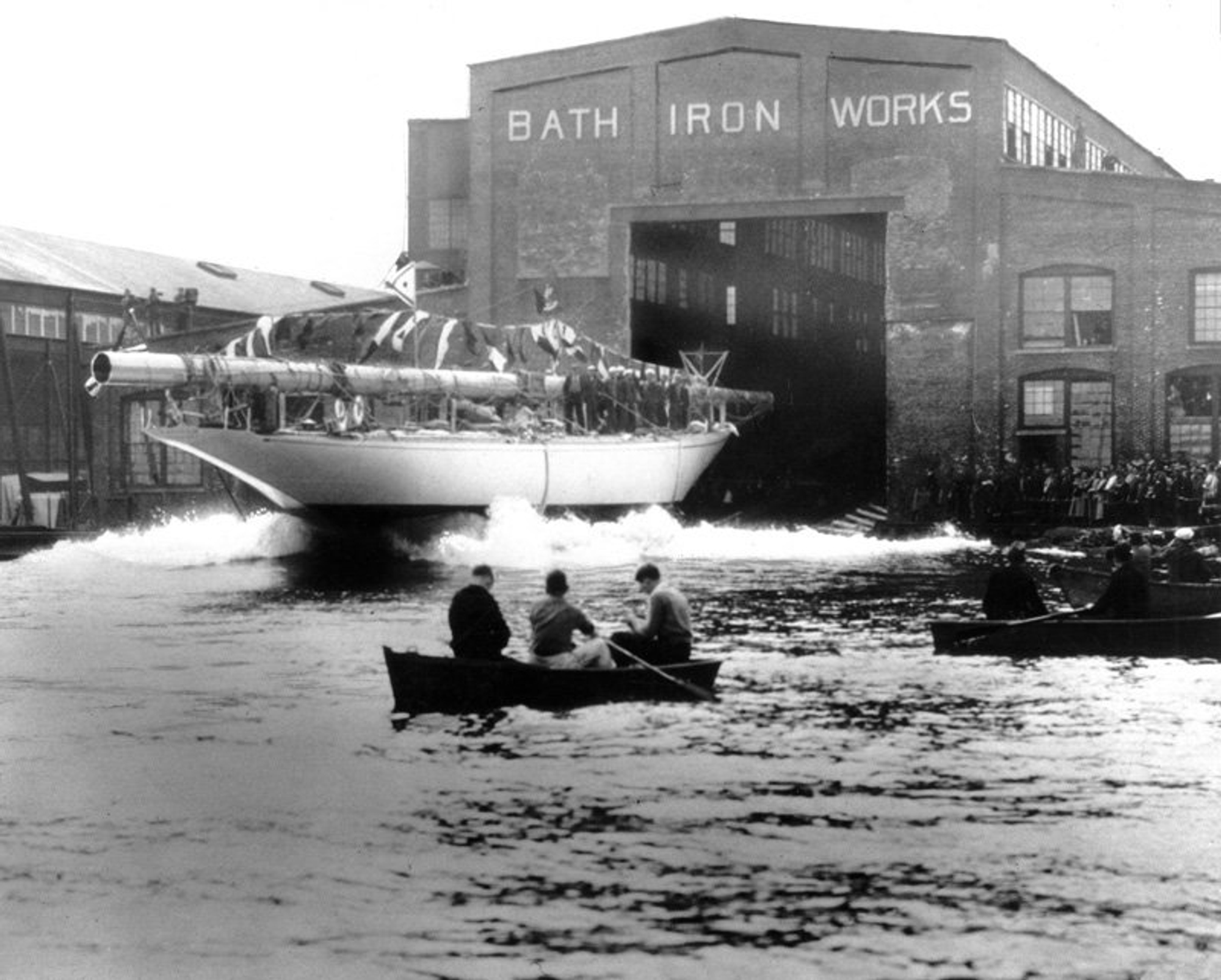
Just like the problems on Endeavour II, Ranger experienced a mast failure on its tow down from Bristol, Maine in a heavy seaway thus proving the fragility of the duralumin masts as feared and in a race against time, the old 1934 mast of Rainbow was stepped whilst a replacement was re-fabricated. At this time, in May 1937, Endeavour II arrived in Newport under tow having sailed the last 720 miles owing to a significant Atlantic storm – remarkably she arrived unscathed minus some rusting on the spar.
Ranger’s preliminary races against Rainbow and Yankee proved that she was a rocket-ship of sorts. Stiff, fast and devastating on a reach, she won each of the three races and entered the defender trials with the notion that she was ‘unbeatable’ – and by the time her replacement mast was stepped, and the old 1934 sails replaced by modern ones, the trials were to be a one-sided affair. Indeed, in one race against Yankee when Ranger won by a massive margin, she did so at an average speed of some 11 knots and set the fastest recorded time ever over the America’s Cup course. The omens were good for a successful defence and Ranger was appointed without question by the New York Yacht Club committee.
Endeavour II’s work-up that summer was almost solely against Endeavour I in a series of practice sessions that roused both suspicion and derision by the yachting journals in America. Sopwith was obsessed with speed trials and manoeuvres, setting exactly the same sail plan on both boats and then proceeding through a set of drills before long runs on opposite tacks before coming back together and then halting the session. De-briefings were long, and crew-work was honed as the memory of poor sail-handling in 1934 was sought to be avenged. Endeavour II was observed by the Americans as being faster on all points of sail than her much-admired predecessor and on July 1st, 1937, the Royal Yacht Squadron confirmed to the NYYC that Endeavour II would be lining up as challenger for the America’s Cup (there was a thought that Sopwith might try and swap out Endeavour II for Endeavour I but this pure media speculation).
Could she match the pace of Ranger though who had spent that summer on their sail wardrobe and in typical Vanderbilt fashion, sought improvements all over?
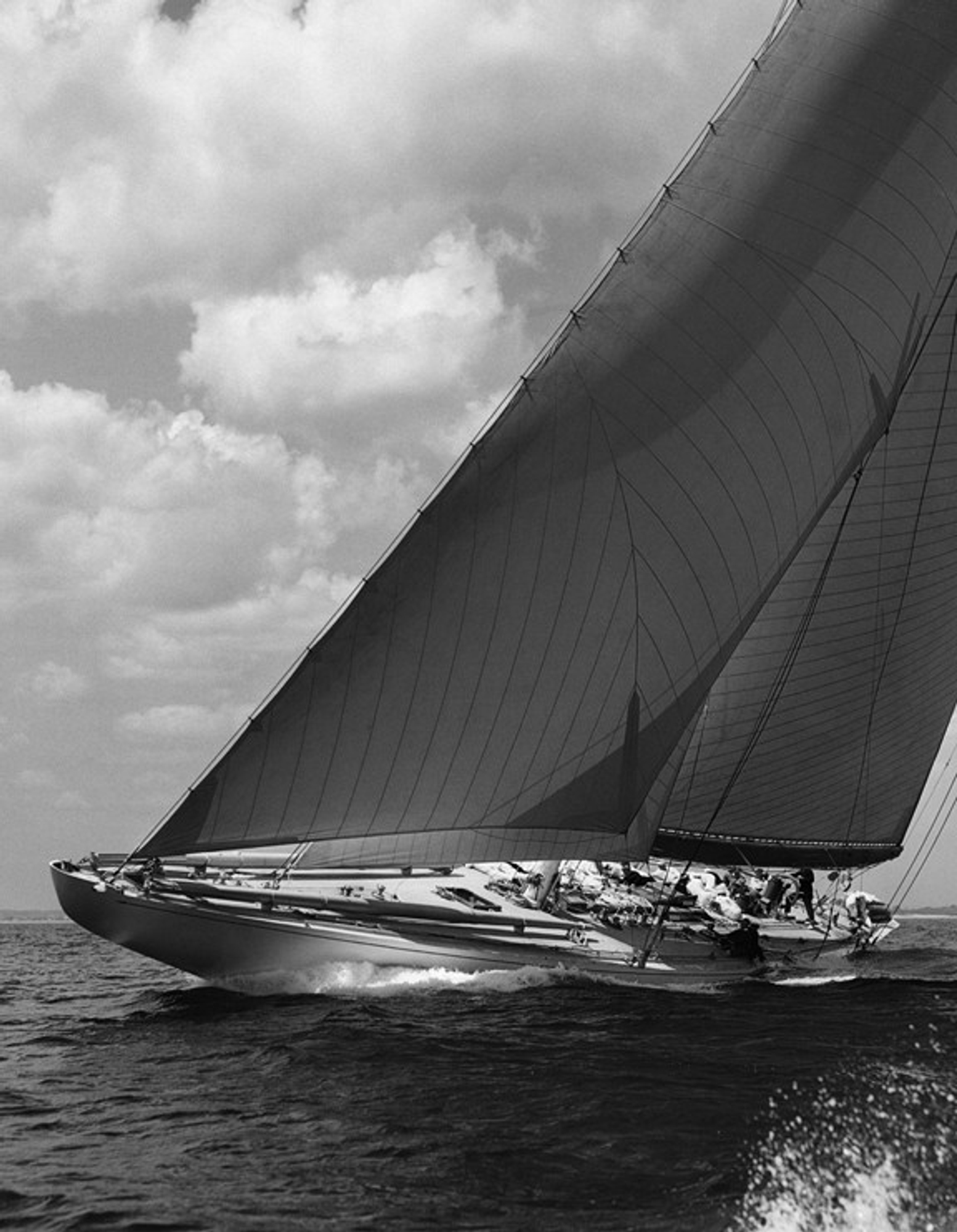
Ranger’s sail inventory that summer was the most remarkable seen on a J-Class to date. The introduction of the enormous 250%, 175% and 135% quadrilateral jibs that were set over over-sized staysails that had been tacked further forward to produce an effective ‘slot’ gave Ranger power unseen before on these boats – and a commensurate beefing up of winches and blocks to cope with the loads was thoroughly worked up through that summer after notable failures in the trials. Vanderbilt was convinced that as much as the waterline length had been a determining factor in 1934, that in 1937 the major gains would be made aloft. Ranger’s mainsail inventory included one from Enterprise of 1930, updated by the City loft of Ratsey’s, a staysail from Vanderbilt’s M-Class ‘Prestige’ and great advances were made both in the spinnaker design, particularly the ballooner, and in how they were handled in manoeuvres. Vanderbilt even mastered a way of gybing with the spinnaker left up that was ultimately outlawed for 1937 but became standard thereafter.
By contrast, Endeavour II’s sail programme had seemingly not advanced from the standard plans of Endeavour I in 1934 and the early loss of two masts in early trials led to caution creeping in on Sopwith’s behalf to push the rig development. It was a fatal error in competitive terms but both boats came to the start of the America’s Cup in 1937 wary of the other and after such a close fight in 1934, the American media assumed that this would be a desperately closely affair once more with some even arguing that a Cup abroad would be good for the future of the sport.
The first race dawned with very light winds on July 31st, 1937, causing the race committee to postpone for 45 minutes to allow the expected breeze to fill in for the planned 30 mile windward / leeward test. Endeavour II got the better of the start, crossing the line ahead by three seconds to leeward of Ranger and able to squeeze up, forcing Vanderbilt to tack away for clear air after 11 minutes.
With clear wind now, and despite Sopwith throwing in a tack to try and cover, Ranger just eased away with Vanderbilt steering loose for speed before coming back to course and after an hour of sailing had left the English challenger almost a mile dead astern. With the breeze freshening, both boats called for a sail change. Vanderbilt was getting increasingly uncomfortable with the 250% quadrilateral in an un-tested wind-range so called for the 175% quadrilateral but the crew, in error, launched the 135% and with Endeavour II swapping from genoa to 175% quadrilateral, for a while the American skipper, although with a healthy lead said that Ranger felt “dead in the water.”
By the top mark, Ranger had clung on and rounded with a lead in excess of six minutes and launched a balloon jib with a light staysail as the wind backed. Sopwith was in gambling territory and sailed high once around the weather mark on the thinking that the incoming breeze with layers of mid-fog would back the breeze further. In short order, the two boats lost sight of each other and as the wind came aft, Ranger launched a light parachute spinnaker formerly seen onboard Yankee and romped home. The margin was astonishing – 17 minutes and 5 seconds – and Endeavour II was in danger of missing the time-limit. Spectators, that numbered some 300 craft of all shapes and sizes, had never seen anything like it in the modern America’s Cup. The early writing was on the wall for the Challenger.
A fresher breeze awaited the yachts for race two with a triangular course set and it was Endeavour II that again made the better start. The practice that Sopwith had executed in the tune up with Endeavour I paid handsomely at close-quarters and a tack beneath Ranger in the dying moments of the pre-start was a textbook move. Ranger, now sitting in backwind dirty air was forced to tack off onto port soon after the start but on the tack back to head out to the left of the course, a top block for the quadrilateral sheeting position exploded and the crew struggled to get optimum trim.
Endeavour II was looking good to maintain her lead and at various points of the first leg she could have easily tacked and crossed, but the race was about to be turned on its head as the English sailed into a light, heading patch of breeze that slowed her dramatically. Ranger came up astern, hit the same pattern and immediately Sopwith tacked in the hope of getting up to speed and crossing the Americans’ bow. Vanderbilt maintained better speed and seeing the English dead in the water, tacked with way under her to leeward and with better crew-work emerged with pace on port tack. Pretty soon Ranger was eking up onto Endeavour II’s line, forcing her to tack off and it was one-way traffic. Ranger extended on the second half of the beat to round 10 minutes 25 seconds up.
With her 250% quadrilateral set – a sail that was nicknamed the ‘Mysterious Montague’ for its inherent cloth being specially developed by DuPont DeNemours Company with rayon and a special coating of aircraft dope – Ranger extended on both reaches of the triangular course. Sopwith had no answer for her waterline speed and superb sail inventory and the winning margin of 18 minutes and 32 seconds was another hammer-blow to the English who simply couldn’t match the super-J creation of Vanderbilt, Burgess and Stephens.
Sopwith called a lay-day to haul Endeavour II out of the water, convinced that she had damaged her centreboard through tangling with a lobster buoy or some other object under the water, so inexplicable was the speed loss on that first beat. “Ranger was pointing much higher, and we could not point any higher than we were. We lost 10 minutes in 5 miles. It is possible we picked up one of those lobster pots,” Sopwith commented afterwards whilst also insisting that some 5,070 pounds of lead were removed from the ballast to improve the light-weather performance. It was time to gamble.
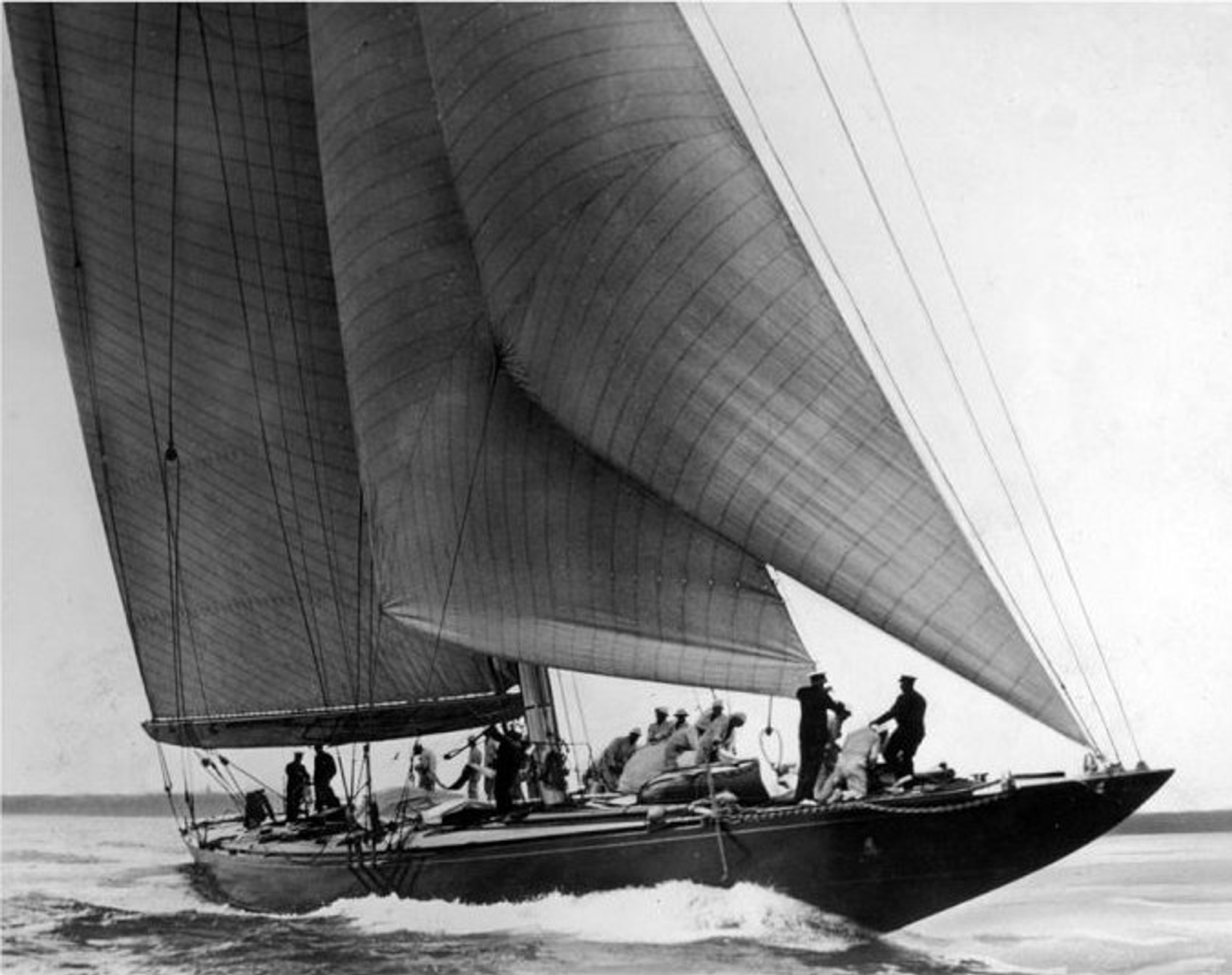
Race three, always a crucial race in these first to four America’s Cup battles where the pendulum can swing or momentum can be carried forward, was do or die for Sopwith but Vanderbilt, smarting from the Dailies taking issue with his starting prowess was more than up for the fight. The windward / leeward course was set in a steady 10 knots of breeze, and it saw the two magnificent J-Class yachts circling aggressively in the pre-start before heading to opposite ends of the start-line on opposite tacks at the gun. Vanderbilt aced the start at the leeward end on starboard tack whilst Sopwith came across 18 seconds down at the other end on port. Sopwith certainly felt that with the reduced ballast, he had the measure of Ranger in a tacking duel and initiated the play which resulted in Ranger’s winch jamming again forcing the quadrilateral sail to be mis-sheeted halfway up the beat.
The wind Gods of Newport however saved the day for Vanderbilt as she sailed a few degrees off the wind but into a favourable shift, keeping Endeavour II on her stern, that allowed Ranger to tack and sail into a lead of 4 minutes and 13 seconds at the top mark – incidentally the fastest recorded time for a 15 mile beat to windward in America’s Cup history.
A split decision upon rounding the windward mark saw Ranger gybe off immediately whilst Endeavour II bore away onto the port gybe with both boats setting spinnakers as the wind increased to 14 knots. For the next 14 miles the boats converged on opposite gybes with Ranger holding the lead but Endeavour II looking the more likely to maintain a direct line to the finish without the need for the costly manoeuvre of gybing. A wind-shift, just a mile from home however, scuppered any chances and both boats were forced to gybe to make the finish with a shy reach to the line calling for a ballooner to be re-launched on the new gybe on both boats. Ranger held on and crossed with a 4 minute 7 second delta and it was match-point to the Americans.
For what proved to be the final race of the America’s Cup in 1937, and in fact the last time that the regatta would be run for the next 21 years, it failed to live up to its billing and an English fight-back was scuppered when Sopwith went over the start-line early. Aggressive tactics from Vanderbilt in the final circle saw Ranger trapping Endeavour II forward and with nowhere to run, she was forced over and Sopwith had to dial away into a gybe and re-cross, losing a minute and fifteen seconds in the process.
Ranger was now unstoppable, sailing in clear air, and matching Endeavour II tack for tack with no discernible loss of speed in the fresh breeze. Vanderbilt had insisted on setting a flat-cut mainsail from the 1930 wardrobe inventory of Enterprise and it was a masterstroke. By the windward mark she was 4 minutes and 5 seconds up and with her 250% quadrilateral set, she powered to the wing mark and despite Endeavour II shaving 30 seconds on that leg, the two boats were even on the final reach to the finish, and it was a resounding win to the Americans of 3 minutes and 37 seconds.
At the finish line, Vanderbilt handed the wheel to Olin and Rod Stephens to cross in a remarkable gesture of recognition at their efforts in producing what was undoubtedly the finest yacht in the world at the time – and considered even today, as the greatest yacht ever to compete in the America’s Cup. She was a marvel of the age and a testament to American design, astute build in strained financial times and Vanderbilt’s undeniable prowess at taking a boat to its racing limits. In subsequent races that summer, she was untouchable, beating all-comers and stamping her authority on the global yachting scene as the marker by which the era would be judged.
For the English it was another disappointment. It was to be T.O.M. Sopwith’s last hurrah in the America’s Cup but he was proud of his efforts saying: “We have had a series of the most wonderfully close races and I find the greatest difficulty in expressing my gratitude to our crew, amateur and professional, for the wonderful work they have done – they have all worked like slaves. May I say that we are not downhearted.”
The America’s Cup in 1937 was the last of the J-Class in the competition. With a pause for the Second World War, the next regatta in 1958 would see the 12-Metre rule adopted and the graceful lines of some of the most iconic yachts ever created would forever more be for the history books or those with deep pockets in modern times to restore, re-build or recreate those fabulous yachts. Only ten J-Class yachts were built, six in America and four in Great Britain, although several boats of the ‘big class’ of the era were adapted to conform to the J-Class rule. It was truly a ‘golden era’ and one that put the America’s Cup very much at the pinnacle of the yacht racing world.
America's Cup A-Z
America's Cup <span class="nav-title__line2">A-Z</span>
The america's cup.
The America’s Cup is one of sailing’s crown jewels, steeped in history but at the cutting edge of technology. Over the years it has seen rich sporting drama, controversy and radical ideas. This A-Z in nautical flags has more. Click or swipe to view interactive. Credit: Kirk and Sons of Cowes / Heritage Images / Getty Images

In 1851, the yacht America won a sailboat race around the Isle of Wight, England. The silver trophy was later renamed the America’s Cup, and is the oldest trophy in international sport. It’s affectionately known as the Auld Mug. Credit: Chris Cameron / AFP / Getty Images

Radical 75-foot monohulls which rise out of the water on T-shaped hydrofoils are the boats for 2021, chosen by defender Emirates Team New Zealand and principal challenger Luna Rossa. Each team can build two boats. Credit: Emirates Team New Zealand

Challengers
Six syndicates will compete for the right to take on Team New Zealand in the America’s Cup. They are Luna Rossa, Britain’s Ineos Team UK, American Magic, Stars and Stripes Team USA, Malta Altus Challenge and DutchSail of the Netherlands. Credit: Amory Ross / NYYC American Magic

Emirates Team New Zealand beat Oracle Team USA in Bermuda in 2017 to earn the right to defend the Cup on home waters. The Kiwis, helmed by Peter Burling (pictured), will take on the winning challenger in March 2021. Credit: Mark Lloyd / AFP / Getty Images

Emirates Team NZ
The Kiwis first won the Cup in 1995 and successfully defended it in Auckland in 2000. They lost it to Swiss-based Alinghi in 2003 and squandered an 8-1 lead to lose 9-8 to Oracle in San Francisco in 2013. But revenge was sweet in 2017. Credit: Chris Cameron / AFP / Getty Images

The Kiwis took the Cup airborne in 2013 when they lifted their 72-foot catamaran out of the water on hydrofoils. Other teams had to scramble to catch up, and though the New Zealanders lost in San Francisco, foiling changed the game. Credit: Ezra Shaw / Getty Images

Not for coffee, but to turn the winches that pull in the sails or control the daggerboards. Traditionally arm-powered, the Kiwis went for radical leg-driven ‘cyclors’ in 2017, since outlawed. Credit: Clive Mason / Getty Images

Hauraki Gulf
Racing in 2021 will take place on Auckland’s Hauraki Gulf and Waitemata Harbour with spectators on land able to see the action up close from North Head and Bastion Point. Credit: Nick Wilson / Getty Images

Some of sailing’s biggest names have graced the Cup, including Americans Dennis Conner and Paul Cayard, Kiwis Peter Blake (pictured), Russell Coutts and Dean Barker, Australian Jimmy Spithill and Britain’s Ben Ainslie, the most decorated Olympic sailor. Credit: Nick Wilson / Allsport

An elegant class of 130-foot, single-masted yacht used in the America’s Cup in the 1930s. Famous names include Shamrock V, Enterprise, Velsheda, Endeavour and Rainbow. Credit: Charles E. Brown / Royal Air Force Museum / Getty Images

Specifically the radical winged keel of Australia II which broke the New York Yacht Club’s 132-year stranglehold on the event when it beat Dennis Conner’s Liberty on the waters of Newport, Rhode Island in 1983. Credit: Tony Feder / Getty Images

Court battles and controversy are as much part of Cup lore as racing. One legal dust-up in 2010 resulted in a one-off match between BMW Oracle’s giant trimaran and Alinghi’s catamaran. Credit: Jose Jordan / AFP / Getty Images

Match racing
The format is a series of head-to-head clashes, known as match racing. Chess-like strategy and an innate knowledge of sailing’s myriad rules is as crucial as boat speed and crew work. Credit: Kos Picture Source / Getty Images

Following the original race, the New York Yacht Club won the next 24 editions of the Cup before losing to Australia II in 1983. For the first time in 15 years, the NYYC club is back. Credit: Dan Nerney

Out-of-the-box
Winning the Cup requires out-of-the-box thinking -- with innovation, invention and inspiration. Left-field ideas have included winged keels, hydrofoils, leg-powered cyclors and a host of funky-looking test boats. Credit: Harry KH / INEOS Team UK

The challenger selection series in which all six syndicates will race in a round-robin format before a knockout phase and best-of-13 final to determine which team will take on the Kiwis in the America’s Cup match. Credit: Olivier Morin / AFP/ Getty Images

Queen Victoria
Britain's Queen Victoria was in Cowes, UK to watch the original 1851 race. She reportedly asked who came second. The reply, which has become the essence of the America's Cup, was said to be: "Your majesty, there is no second." Credit: Leonello Bertolucci / Getty Images

Traditionally a rich person’s playground, big-bucks backers include railroad executive Harold Vanderbilt, tea baron Thomas Lipton, CNN founder Ted Turner, Oracle chief Larry Ellison and Prada CEO Patrizio Bertelli. Now the UK's richest man Jim Ratcliffe is bankrolling the Brits. Credit: FPG / Getty Images

Following the death of Andrew Simpson in 2013, safety is paramount. Warp speeds and wipeouts call for helmets, life vests, emergency oxygen and knives to cut away rigging after a capsize, while rescue divers follow in chase boats. Credit: Amory Ross / NYYC American Magic

From wooden to carbon fiber boats, winged keels to foiling catamarans, and artificial intelligence analysing thousands of terabytes of data in real time, technology is a cornerstone of the Cup. Credit: Josh Edelson / AFP / Getty Images

United States
The competition has been dominated by US syndicates ever since the first race in 1851. Of the following 34 editions, US yachts have featured in the America’s Cup match on all but three occasions (2000, 2003, 2007), winning 29 times. Credit: Noah Berger / AFP / Getty Images

Foiling has upped the ante in the speed stakes with the AC50s racing across Bermuda’s Great Sound at more than 50 knots (nearly 60mph). Computer models suggest the AC75s for 2021 could be even faster yet. Credit: Clive Mason / Getty Images

It’s been a man’s world for most of its history, barring the mostly all-female crew of Mighty Mary in the 1995 US trials, but Dutchwoman Carolijn Brouwer could become the first female helm in 2021, racing for DutchSail. Credit: Jesus Renedo / Volvo Ocean Race

To win the America’s Cup you need the budget, the boat, the designers, the sailors, the shore team and luck. Even then, it helps to have some X-factor. Credit: Clive Mason / Getty Images

Yacht clubs
Each syndicate represents a host yacht club, all prestigious institutions with blazers aplenty. Think New York Yacht Club, Great Britain’s Royal Yacht Squadron, or the Royal New Zealand Yacht Squadron. Credit: ETNZ / Carlo Borlenghi

The America’s Cup is the pinnacle of inshore sail racing, the Formula 1 of yachting. Rooted in history, it embraces the technology of the future and is one of the most coveted prizes in sport. Credit: Simon Watts / Getty Images
More from CNN Sailing

- Words by Rob Hodgetts
- Design and Development Brad Yendle, Byron Manley, Mark Oliver and Henrik Pettersson
- Terms of Use
- Privacy Policy
- Private Charters: (401) 849-5868
- Ticketed Sails: (401) 846-9886
l2 US 22 Intrepid
1967 & 1970 winner of the america's cup.
Year Built: 1967 Yacht Designer: Sparkman & Stephens Yacht Builder: Minneford Yacht Yard, City Island, NY Syndicate: N/A
Twice Winner of the America’s Cup, the incomparable 12 Meter Intrepid is close to the hearts of many sailors. 12 US 22 is one of the most famous racing yachts of all time.
Built of double planked mahogany on white oak frames, Intrepid marked a major breakthrough in Twelve Meter design, separating the rudder from the keel, including a “bustle” or “kicker”, and adding a trim tab. This unique underbody type, designed by the legendary Olin Stephens, was imitated on every subsequent Cup boat until Australia II , came out with her winged keel in 1983.
Skippered by “Bus” Mosbacher, she completely crushed the competition, including the unfortunate Australian challenger Dame Pattie , to win the Cup in 1967. After being revamped by Britton Chance in 1970, with Bill Ficker at the helm, Intrepid sailed to her second America’s Cup victory, defeating Gretel II .
Intrepid remained very competitive well into the era of the aluminum 12 Meter yachts. Redesigned yet again in 1974 by Olin Stephens and his team at Sparkman & Stephens, she competed for an unprecedented third time under the command of Californian Gerry Driscoll. Intrepid came within one race of becoming the only three time America’s Cup Defender in history, losing the final race of the Defender trials to Ted Hood on the brand new Courageous .
ACC proudly offers the incomparable Intrepid for charter out of Newport, RI – strong, fast and graceful she provides a lifetime of cherished memories for all who sail her,
Have questions?
©2022 America’s Cup Charters. All Rights Reserved.
- Bahasa Indonesia
- Slovenščina
- Science & Tech
- Russian Kitchen
7 most PRESTIGIOUS & EXPENSIVE districts in (and near) Moscow
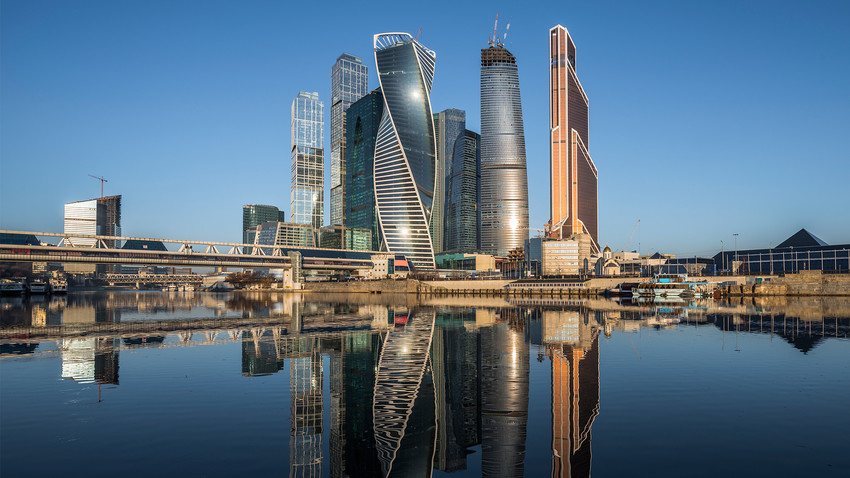
1. Rublevka

Rublevka, simply put, is Russia’s “Beverly Hills”: home to rich, famous, and influential Russians who live in luxury, hidden behind tall fences and walls. Technically, it is located outside Moscow, some 10 kilometers to the west via the Rublevo-Uspenskoe Highway, yet the area, and its residents, are nonetheless an integral part of Russia’s capital.
Officially, there is no such an administrative unit as Rublevka. Instead, the name of the area is a social construction, popularised in mass culture as a synonym of being filthy rich, as it is one of the most expensive residential areas in the world. It is also a play of words as – you know it – the ruble is the Russian currency.
In Tsarist Russia, nobility built homes here, only to be replaced by dachas of Lenin, Stalin, and other state officials after the Bolshevik Revolution. In Soviet times, famous scientists, artists, and writers — including Mstislav Rostropovich, Andrei Sakharov, Dmitry Shostakovich — had dachas in Rublevka. Today, Rublevka is inhabited by oligarchs, multi-millionaires, and all-powerful figures. The Russian President’s official residence is in Novo-Ogaryevo – not far from Rublevka.
Although Rublevka is considered the most famous luxury residential area in the immediate vicinity of Moscow, there are many other elite villages and areas in the Moscow Region, most of which are located to the west of the capital.
2. Ostozhenka and the ‘Golden Mile’
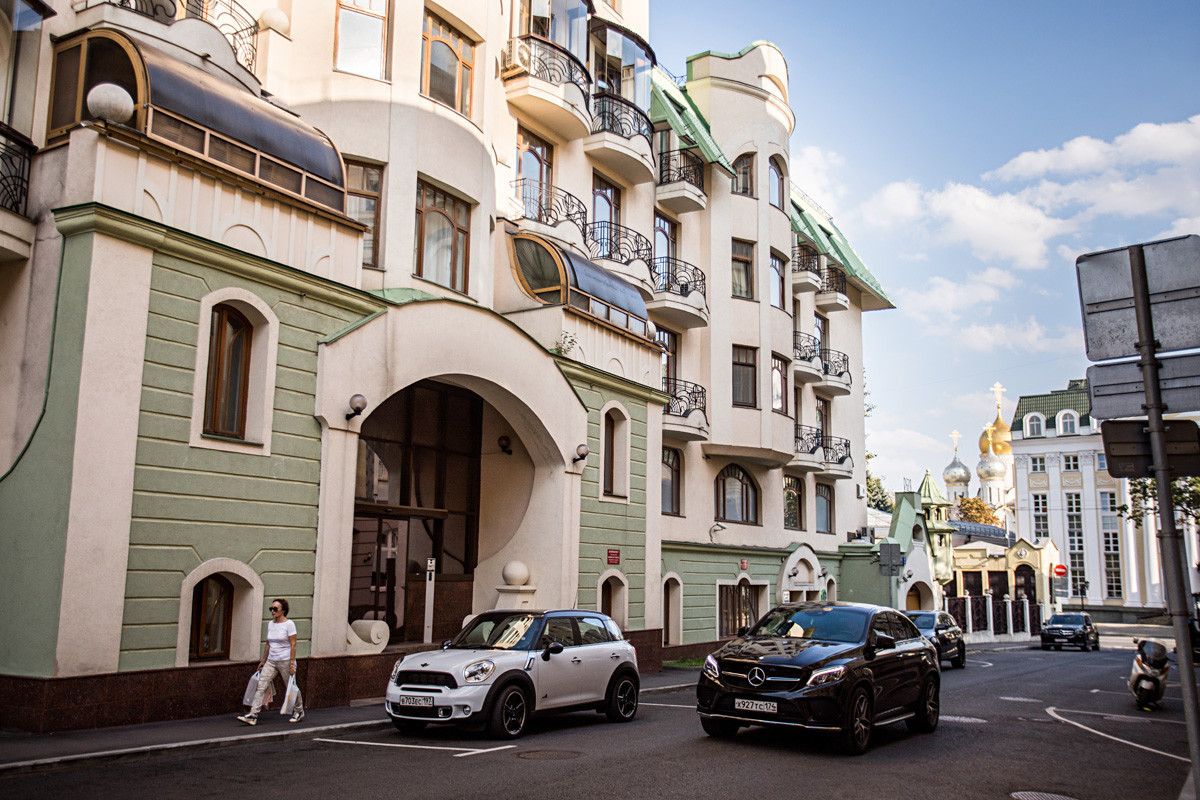
The Golden Mile is an unofficial name for one of the most expensive residential areas in Moscow. It is a small piece of land where luxury real estate has been built. It is located between Ostozhenka Street and Prechistenskaya Embankment, a 10-15 minute walk from the Kremlin, with some of the buildings overlooking the Moscow River.
With prices up to $40,000 for a square meter, Ostozhenka is often listed among the most expensive streets in the world. Given that an average apartment there is around 240 square meters in size, the price tag for it can reach as high as $10 million or even more.
“[Before 1989], this area was abandoned, because of the planned construction of the Palace of the Soviets (which was to be built on the site of the Cathedral of Christ the Saviour). The entire area was planned to be cleared to make possible the construction of a wide avenue leading to the Lenin Hills [currently known as Vorobyovy Gory],” says Alexander Skokan, an architect and a founder of the Ostozhenka Bureau.
However, the Palace of the Soviets was never built. Instead, luxury houses began to be erected there. Consequently, it may be hard to come by residents in this area, as most of the buildings have been bought for investment purposes.
3. Khamovniki
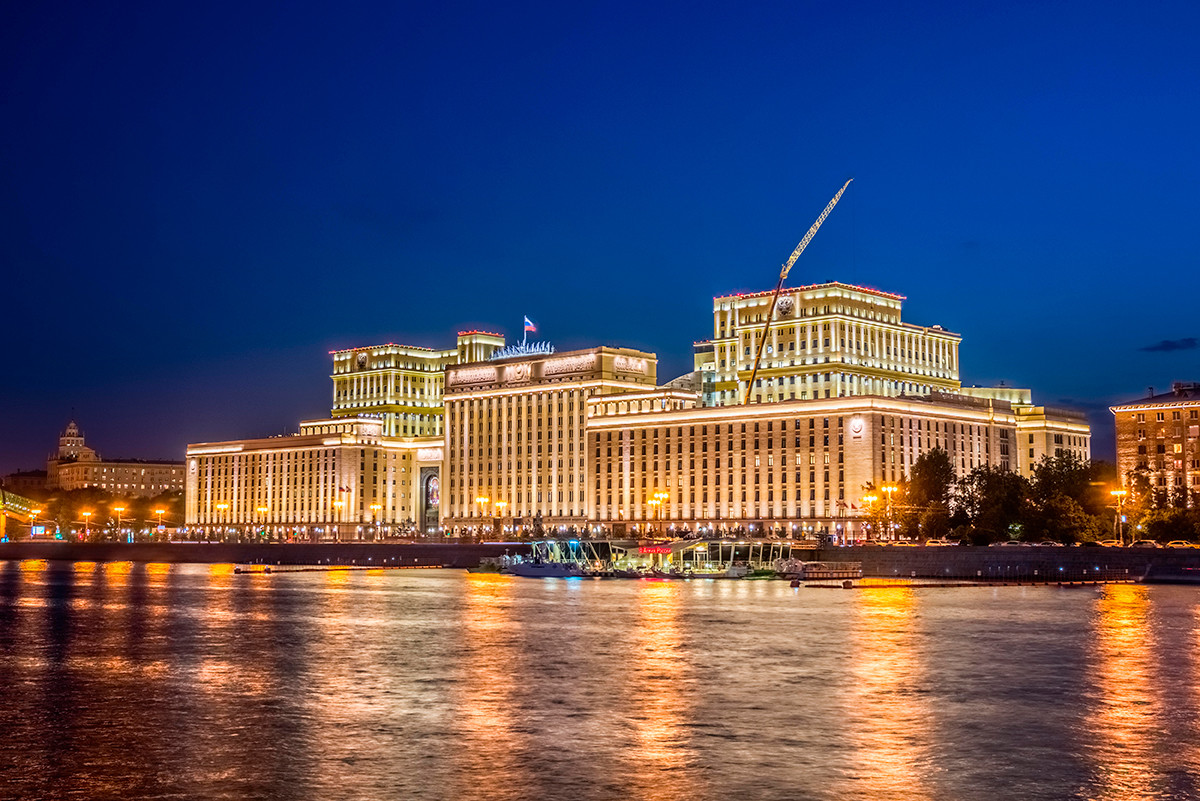
Khamovniki is the official name of a district located in central Moscow. It starts from Aleksandrovskiy Sad next to the Kremlin and spreads across to the Luzhniki Stadium and Sparrow Hills (Vorobyovy Gory) in the western part of the city.
Historically, this is where weavers used to live, who were known as ‘Khamovniki’ in the 17th century. Hence, the name of this historic district.
Today, Khamovniki is one of the most popular areas of the Russian capital among apartment buyers. Yet, it’s also one of the most expensive districts in Moscow, where one square meter of apartment costs approximately $11,000; a price tag far beyond the average in Moscow.
The Moscow River, multiple parks and numerous metro stations make this elite district ecologically clean and also easily accessible from anywhere in the city. Pre-revolutionary houses, Soviet buildings and modern projects are available on this stretch of land. Among others, one of Russia’s greatest writers Leo Tolstoy owned an estate in Khamovniki in 1882 (which is now part of his family estate).
4. Yakimanka
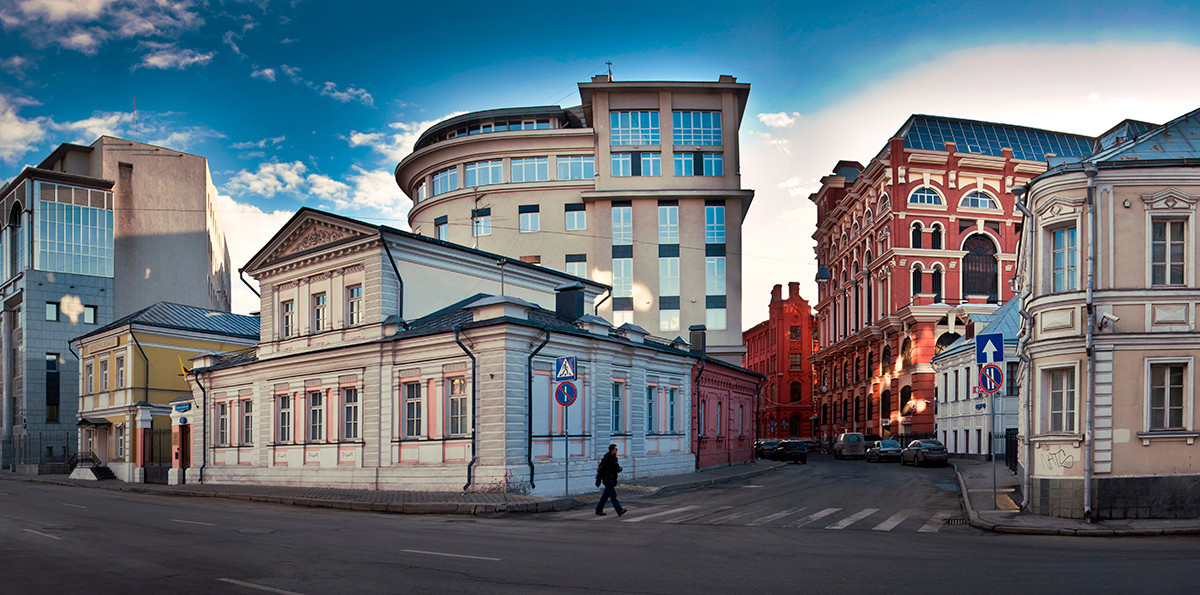
This is a neighboring district to Khamovniki, lying to the Southwest of the city center. Everyone who has ever been to Moscow knows Gorky Park, which covers most of the district’s territory. Yakimanka is one of the most stylish areas in Moscow and it is well known for its clubs, cocktail bars and cozy restaurants, as well as for the State Tretyakov Gallery and the Muzeon Park of Arts.
The district is also home to old factories built in the early 19th century. Most of these buildings have been rebuilt as offices. Elite real estate in this district may also cost up to $20,000 per square meter.

This is another historic and luxurious district, craved by anyone who dreams of settling in Moscow. It stretches from the Moscow Kremlin on the west to the Moscow River in the east, with New Arbat Avenue being its major artery. Here, the famous Spaso House , the residence of the U.S. ambassador to Russia since 1933, is located, as well as other historical landmarks .
As in many other districts in Moscow, Arbat has it all when it comes to real estate: pre-revolutionary houses, Soviet buildings and modern luxury apartment blocks. An average price tag for a square meter of real estate here is $10,000. Yet, naturally, you can find much more expensive housing than that in the area.
6. ‘Presnya’
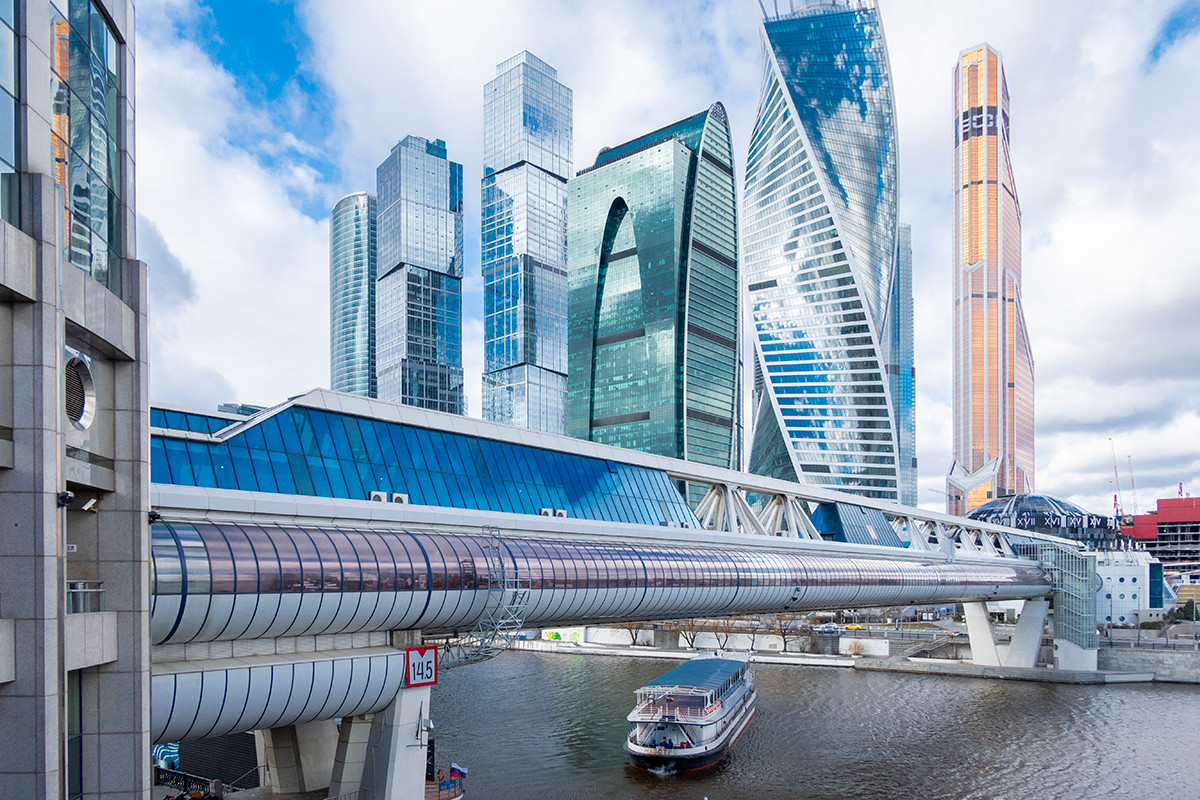
The Presnensky district, as it is officially known, lies to the immediate north of the Arbat district. Although real estate here is generally not as expensive as in the above-mentioned districts, there are two especially affluent areas that make the average price tag skyrocket: Patriarch Ponds and the Moscow City business center, where the famous skyscrapers are located.
One square meter in one of the towers of the Moscow City business center can cost up to $20,000. Considering there are premium apartments that take a whole or even multiple levels, the final price can be extremely high.
7. Tverskoy, Meschansky, and Zamoskvorechye
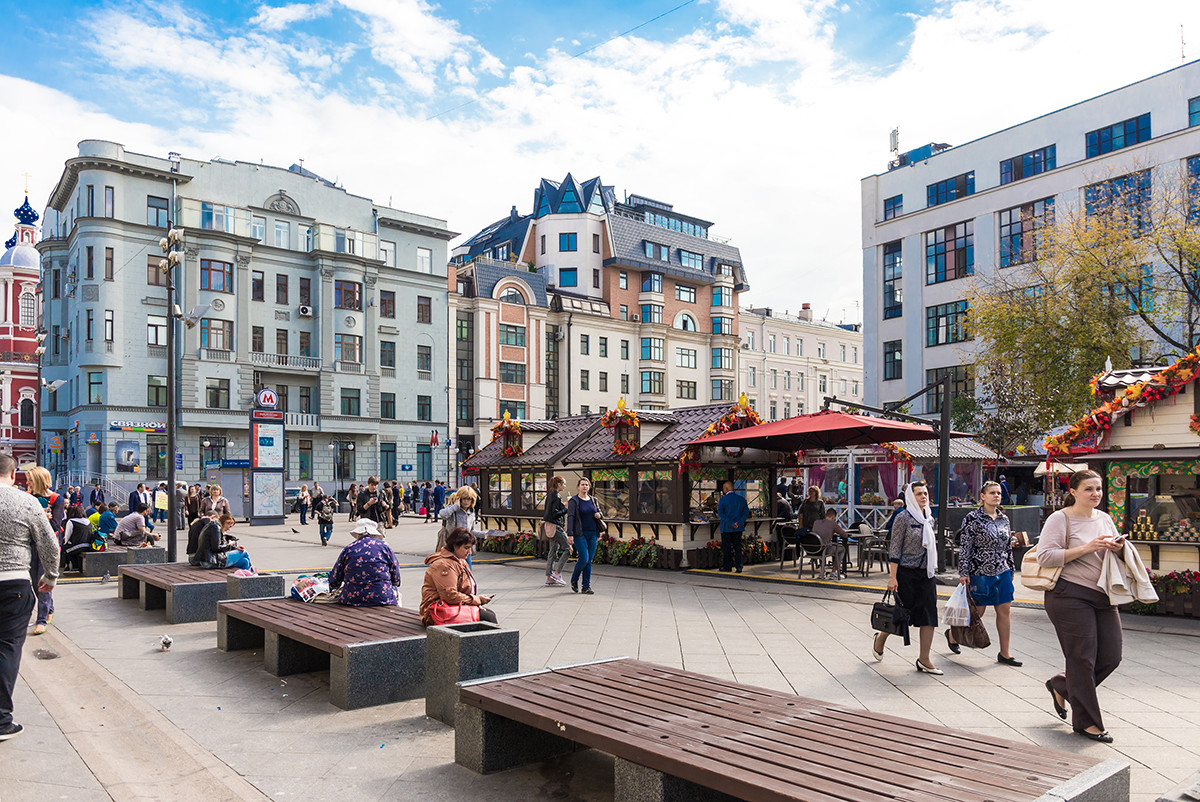
Zamoskvorechye.
These three districts — two to the north of the Kremlin and one to the south — are all affluent areas of the city. The State Duma and the Governor-General Building (which today is the Moscow Mayor's Office), among other important buildings, are located in Tverskoy district.
These three districts are similar to each other in the sense that they lack vacant land to make major new development projects possible. Instead, a relatively small number of offers is on the market. The average price of one square meter of housing in these areas amounts to $7,300.
Click here to find out what to sightsee on Tverskaya street.
If using any of Russia Beyond's content, partly or in full, always provide an active hyperlink to the original material.
to our newsletter!
Get the week's best stories straight to your inbox
- 5 must-visit places in Moscow
- 50 things you must do in Moscow: Our randomized guide!
- Why is Moskva called Moscow in English?
This website uses cookies. Click here to find out more.
JAVASCRIPT IS DISABLED. Please enable JavaScript on your browser to best view this site.
Historic America's Cup Paintings
The extraordinary yachting art of russ kramer.

Marine Artist Russ Kramer of Mystic, Connecticut, specializes in fine art recreations of famous yacht races such as the America’s Cup and scenes of Gilded Age yachting life. Combining historic, maritime and figurative themes, his paintings are often from a thrilling first-person viewpoint, or a compelling birds-eye view. He has painted all the early America’s Cup races from the first, the Yacht America’s 1851 defeat of an entire fleet of the finest English yachts through the J-boat yacht Ranger of 1937. Two 12-meter races, yacht Weatherly in 1962 and yacht Intrepid in 1970 are also depicted. Russ has also painted several of the early and famous Bermuda Race yachts such as Tamerlane, Hutoka and Finisterre. All of Russ Kramer’s yacht paintings are available in limited edition prints on both paper and canvas, signed and numbered by the artist. Canvas prints are enhanced by the artist using a textured gel varnish which gives them the look and feel of an original painting. Russ has been featured in Yachting magazine, Sail magazine, Wooden Boat magazine and Classic Boat magazine among many others. He also works on commissioned yacht portraits and family experiences on the water. He is the current President of the American Society of Marine Artists, and is represented by the Maritime Gallery at Mystic Seaport, Connecticut, the J. Russell Jinishian Gallery in Fairfield Connecticut, the Roger King Gallery in Newport, Rhode Island and the ICON Gallery in Alexandria Virginia. Click on any image above to see more information on a famous America’s Cup race and order a print of any of these America’s Cup paintings.
America’s Cup art America’s Cup paintings Americas Cup fine art prints America’s Cup prints America’s Cup history Yacht America America’s cup 1851 Yacht Magic America’s cup 1870 Yacht Columbia America’s Cup 1871 Yacht Livonia America’s Cup 1871 Yacht Madeleine America’s Cup 1876 Yacht Mischief America’s Cup 1881 Yacht Puritan America’s Cup 1885 Yacht Mayflower America’s Cup 1886 Yacht Volunteer America’s Cup 1887 Yacht Vigilant America’s Cup 1893 Yacht Defender America’s Cup 1895 Yacht Columbia America’s Cup 1899 Yacht Columbia America’s Cup 1901 Yacht Reliance America’s Cup 1903 Yacht Resolute America’s Cup 1920 Yacht Enterprise America’s Cup 1930 Yacht Weetamoe America’s Cup 1930 Yacht Whirlwind America’s Cup 1930 Yacht Weatherly America’s Cup 1962 Yacht Intrepid America’s Cup 1970
17 Exciting Things to do in Moscow
Written By: Linda Voltaire
Updated On: December 21, 2022
Visiting Russia? These are the top 17 things to do in Moscow to help you plan your trip.
If the western world has New York City , the first great metropolis on the eastern side of our planet is Moscow. A huge city with a complicated and impressive history, Moscow gets a bad rep over Russian politics – but that doesn’t make it any less impressive. Capital to the largest country in the world, Moscow takes the grandeur of its standing very seriously.
This is a place where luxury is king and where opulence takes a front seat in every aspect of life. The buildings are grand and imposing, the parks are luscious and enormous, and even the subway stations look different in Moscow than anywhere else in the world.
Table of Contents
Best Things to do in Moscow, Russia
Walking around Moscow is also going through the tumultuous history of the 20th century, which had Russia as one of its main protagonists. There are fascinating remains of these times everywhere in the former Soviet capital, from the gorgeous Seven Sisters skyscrapers to the Orthodox cathedrals that were closed for the better part of a century. Still, Moscow is also a completely modern city, with a vibrant social and party scene, incredible restaurants, and some of the most luxurious hotels in the world.
After living in Russia’s capital as an ex-pat for four years, I got the privilege to experience not only the main attractions in Moscow but also the everyday life in this huge city and quickly found my sweat spots off the beaten tracks! So here is my list of my top 17 things to do in this exciting metropolis!
Attractions in Moscow
When visiting a famous city like this one, it’s a must to go through the most iconic landmarks first. Moscow has plenty of those, most of them in the center of the city, which is very well-planned for tourists.
1. The Red Square, Kremlin & Surrounding Area
No place tells the story of Moscow’s power in the past century the way the Red Square does. This is where the biggest political meetings in the USSR occurred for many decades, and you can feel the power on each step.
Here, you’ll also find the historic museum at the entrance, showcasing the decades of history behind this iconic landmark. The Lenin Mausoleum, perhaps the most famous resting place in the world and home to the remains of the former communist leader, is also here.
On one side of the Red Square you’ll find the Kremlin, the fortified complex that now hosts the presidential residence. This is also home to the most iconic of all Moscovite landmarks: St. Basil’s Cathedral, a 16th-century marvel of colors. This is the best spot to take a selfie and show the world you’ve reached the Russian capital!
- Get your Kremlin Skip the Line Tickets and Kremlin tour here.
- Free cancellation up to 24-hours in advance of the tour.
2. Bolshoi Theatre
You can easily spend a couple of days just exploring the Moscovite city centre, and the Bolshoi Theatre should be your second stop. Walk past the Red Square and then head to the nearby Bolshoi Theatre, one of the oldest and most renowned houses of opera and ballet on Earth.
Visit for the impressive early 19th-century architecture, but if you’re seeing a ballet performance, make sure you book between 3 and 6 months in advance! I can strongly recommend this as it is a truly unique experience!
- Book a private 2-hour tour of the legendary Bolshoi Theatre.
- See the presidential box reserved for tzars, watch a rehearsal and skip the lines through a separate entrance.
- Free Cancellation up to 24-hours in advance.
3. Luxury Shopping at GUM and TSUM
While many might think of Moscow as the sad place with the long bread queues from the USSR days, it’s been quite the capitalist haven for a while.
If you’re up for some shopping, you’ll find one of the biggest luxury malls in town, TSUM, right behind the Bolshoi and GUM, at the red square. GUM is the most famous department store in town, where you’ll find luxury everywhere and all high-end brand.
All in an imposing late 19th-century building with lots of history, worth a visit just for the design, its bridges and the glass roof even though you are not up for shopping!
4. Christ the Savior Cathedral
A newer addition to the gorgeous Moscovite cathedrals and my grandeur neighbor during my years in the city Don’t let the young age of this building fool you. After the perestroika in the early 90s, the newly revived Russian Orthodox Church received permission to build a cathedral on this site. They did the location honors and built the largest temple of the Christian Orthodox Church.
The façade is as grand as you’d expect, but it’s the inside that will mesmerize you, with its domes as tall as the skies in bright gold and gorgeous paintings and decor! Bring a shawl to cover your hair to adjust to the local tradition.
Head to the back of the cathedral and you will find one of the most photographed bridges in Moscow, the Patriarshiy Most. This is the perfect spot to get a good view and photo of the cathedral but also to see the Kreml and Gorky Park from a distance. Or why not just enjoy a moment watching the river and its boats!
- Get around Moscow with ease using the Hop On Hop Off boat and Bus ticket. 24, 48 or 72-hour tickets available.
5. Gorky Park
Cross the river and head to Gorky Park along the Moscow river. The most famous green area in town, similar to New York ’s Central Park and the weekend hangout for locals. There are many beautiful parks in the city, but if you’re only visiting for a few days, this is the unmissable one!
With fair attractions to entertain children, beautiful artificial lakes and gardens, and lots of outdoor activities, it’s a lovely place to relax. A place of rest in the middle of the metropolis. The area in front of the New Tretyakov Gallery & the Muzeon Park of Arts is actually one of my favorite oasis as a bit more quiet and peaceful than Gorky itself.
Why not spend some time in the museum to get a great tour of Russia’s history through art or just enjoy the art exhibition outside where local artists spend their weekends.
6. River Cruising
One of the best ways to experience Moscow is from the Moscow River. There are many stops for the boats and one is just next to Gorky Park. See the city from another perspective – and turn the ride into a romantic one by taking the evening cruise. Moscow is magic during the night.
If you’re looking for a truly luxurious experience, take the Radisson Blu cruise – or the Erwin for a delicious seafood dinner. Both stop at Gorky or at the luxury Radisson Royal Hotel, set in one of the Seven Sister’s skyscrapers.
- We use Get Your Guide when booking city tours and they offer a River Sightseeing Cruise seeing all the main tourist attractions in Moscow
7. Metro Hopping
First inaugurated in the 1930s, the Moscow subway system is one of the oldest in the world, and certainly the most beautiful. Started under Stalinist times, each metro station is dedicated to grandeur and oozing personality.
Visiting the subway stops is an attraction in and of itself, and Komsomolskaya, Mayakovskaya, Kropotkinskaya are my favorites. Those surrounding the Red Square are also mesmerizing – in general, these are kind of like underground palaces.
Most of the signs at the Moscow Metro now have Latin letters, so it’s very easy to get around!Unfortunately, the trains are not as beautiful and pleasant as the stations but still, this is a true Moscow experience. Take a guided tour of the 9 most beautiful Metro Stations including the award-winning art deco station. See more details here.
8. Arbatskaya & Artsy Moscow
Novy Arbat Street is one of the most touristy areas in the city, with lots of shops and cafés directed at visitors. When you walk a little beyond, you’ll find a different part of town, where the hip scene thrives because so many artists live in the area. Just follow the small streets with fewer tourists!
9. Moscow State University View
In his effort to create a grander Moscow, Stalin had seven skyscrapers built in different parts of town; they’re called the Seven Sisters. The largest of these buildings hosts the main building of the Moscow State University, one of the most prestigious colleges in Russia – and the one with the best view.
Although this is a little outside the city centre, the sight from above is more than worth it, with the nearby fountains and park and then the whole of the city behind them.
10. Russian Market
If you love to visit markets wherever you go, Moscow has one of the most impressive ones in the world – the Izmailovsky. You can easily take the metro here and feel like you’ve been transported to another time.
This place was first built in the 16th century and retains the look of an old fairytale, with a lineup of colorful old castle. A lovely local experience beyond the confines of the bustling metropolis, where you can also try some delicious Russian barbecue.
Here, you’ll find beautiful souvenirs at great prices.
Off The Beaten Track Moscow
Once you’ve covered the most touristic spots, Moscow still has plenty to offer – and the places below will also be full of locals! Moscow is a city for hipsters, full of trendy and arty spots where you can literally feel the creativity oozing! So for some local vibes, I would strongly recommend my sweat spots below!
11. Patriarshiye Prudy
This is my favorite area in the entire city! While Moscow is generally a very noisy metropolis, Patriarch Ponds is far quieter, yet such a vibrant place. This is a very hip and trendy area making you think you are rather in Paris than in Moscow. Here the streets are narrow and full of chic eateries and clubs to see the local crowd.
A little bohemian and with an air of peace you won’t find anywhere in the city this is a great spot to spend an afternoon with your thoughts.
12. ArtPlay
Barely 15 minutes away from the city center you’ll find the artsiest Moscow district: ArtPlay. For decades, this block was a factory, but it was renovated to become a hub for the arts not too long ago.
Now, you’ll find it’s full of exhibitions, showrooms and art schools – and some of the most creative people in town. Writers, painters, and young hip people use ArtPlay as a rendezvous, and you can feel the creative energy here. The industrial design with modern interior decoration is also a feast for the eyes!
13. Shopping Local Designs
If you’re into design, both international and local, you’ll find lots of cute things at Patriarshiye Prudy. Department store Podium Market is also a great spot for shopping, as a department store everywhere in town, with lots of local and international brands. There’s one in the Four Seasons Hotel next to Red Square. My favorite Moscow mall is Tsvetnoy Central Market, a cool spot with great brands, lots of inspo, and even a cute café!
14. Moscow City
Like many other great capitals of the world, for the past few decades, Moscow has hosted a super modern area full of modern skyscrapers – Moscow City. With a completely different vibe than the rest of town, it’s like a mini Dubai, with lots of impressively tall glass buildings. Here, you’ll find the best rooftops in towns, such as Ruski and Sixty they are perfect spots for dining or enjoying a glass of wine with a view. There are also a relatively new shopping mall with lots of international brands called Affimall!
Wine, Dine, and Party in Moscow
Gone are the gloomy Moscow days – cold as it might be in the winter, Russia’s capital is a place for the senses. Great food and drinks abound – and the clubs are hot, too!
15. Where to Eat in Moscow
Moscow is a great metropolis where people love to dine out, and there are endless options for delicious food. The flavors are as diverse as you’d expect from a big city, with options of fine dining and little hipster eateries.
- For traditional Russian flavors, I can’t recommend Café Pushkin, Dr. Zhivago, and Turnadot enough.
- When looking for international cuisines, Italian is always the way to go, and my local favorite is Probka.
- Fine dining is best done among the clouds at White Rabbit, with European flavors.
- As for the hip spots, you can spend a full day just eating around trendy places, from burgers to Asian fusion.
More Dining Options
- Patriarshiye Prudy offers a lot of small and classy spots with cool concepts, like breakfast restaurants I Love Cake and Fresh.
- For dinner, I love the NYC experience of Saxon & Parole, and the wonderful trendy Pins, with its delicious food and drinks.
- For delicious Asian food head to CutFish.
- Lastly, there’s a recent revival of food markets in Moscow, offering lots of great choices of international flavors at affordable places.
- Don’t miss out the Vietnamese food stand at the Danilovsky market, and everything at Usachevsky!
16. Rooftopping
Big cities deserve to be seen from above, having a cocktail among the clouds. These are my recommendations for rooftop bars in Moscow.
- As I mentioned in the Moscow City section, Sixty & Ruski are two of my favorites, overlooking the newest part of town.
- White Rabbit and its fine dining is also a lovely place for a fun dinner looking down on Moscow.
- O2, in the city center, has an advantage above all others: amazing views of the Red Square.
- Buono, above the Radisson Royal Hotel, might be the most romantic rooftop hotel in town, with its candlelit setting.
- Also on the Radisson stands the Mercedes. It’s a luxurious and posh experience with delicious cocktails.
- The Sky Lounge offers a peculiar experience, mixing an old Soviet building with futuristic additions.
17. Moscow by Night
Party the night away! The city is full of bars everywhere, but there are some areas where you’ll find more than others.
- Patriarshiye Prudy has lots of hip and small clubs and great bars, including the super fun private club Clava, which has a great vibe and people from all walks of life.
- For more hipster style bars, Red October is the place to go.
- Streak is a summer favorite, with a lovely terrace to catch a beautiful sunset – plus, their mozzarella bar is delicious.
- At night, Red October lights up with clubs everywhere, including the cool rooftop one Gipsy.
- Jagger is also a great spot during summer with a more relaxed vibe in garden setting.
- For the traditional Russian luxury experience, go to SohoRooms, a whole other world including all-night go-go dancers.
There are so many things to do in Moscow at night and during the day, you definitely need several days to explore this exciting destination.
Moscow is a must-see city, a city like no other ! I hope you will enjoy this Russian metropolis as much as I did!
If you enjoyed this article on the , share it to Pinterest for future travel planning.
- Mother Russia Stands Proud at Volgograd
- 25 Haunting Chernobyl Pictures – 3 Decades after the Disaster
- 10 Reasons to Add Tbilisi Georgia to Your Bucket List
Follow Linda on Instagram guides! For more inspiration, follow my journey also on Facebook and Pinterest and see Linda’s bio below for more at her website.
Travel Planning Resources
Looking to book your next trip? Why not use these resources that are tried and tested by yours truly.
Flights: Start planning your trip by finding the best flight deals on Skyscanner
Book your Hotel: Find the best prices on hotels with these two providers. If you are located in Europe use Booking.com and if you are anywhere else use TripAdvisor
Find Apartment Rentals: You will find the cheapest prices on apartment rentals with VRBO .
Travel Insurance: Don't leave home without it. Here is what we recommend:
- Allianz - Occasional Travelers.
- Medjet - Global air medical transport and travel security.
Need more help planning your trip? Make sure to check out our Resources Page where we highlight all the great companies that we trust when we are traveling.
You May Also Like
16 Interesting and Surprising Facts About Russia
12 Beautiful Reasons to Visit Tbilisi, Georgia
Motherland Calls – Mother Russia Stands Proud Over Volgograd
About Linda Voltaire
Linda Voltaire is the owner of Travel with a Silver Lining, home to reviews of gorgeous boutique & design hotels, hip & trendy eateries as well as authentic and personal travel experiences beyond the crowd. She started blogging after a life-changing trip across South America. Follow Linda at TravelWithASilverLining / Facebook / Instagram /
Join thousands of others who get our monthly updates!
Leave a comment cancel reply.
Save my name, email, and website in this browser for the next time I comment.
10 thoughts on “17 Exciting Things to do in Moscow”
These places look so awesome! Moscow is truly a beautiful city
Very good article, you have explained so nicely. Russia has always been a part of history and its good to know about much more about architecture and other things, wish i could see the inside of façade
Thanks for sharing such a nice article.You have very beautifully explained everything that one need for a trip to Moscow.
Nice article. Love the hidden gems and graffiti art, would love to visit Artplay. Thanks for a comprehensive guide to Moscow!
Moscow is a city where the past and the future live side by side. Here we can find everything from medieval fortresses and Soviet monoliths to glass skyscrapers and innovation centers.
Your article is good and meaningful .
Thanks for sharing about ArtPlay district, we didn’t know about it and it looks amazing 🙂 Hopefully there’ll be a second time in Moscow, we visited last May and really liked the city!
Wonderful stuff! I’ve been to Moscow, but not properly – it’s a long story lol!
Anyhoo, my next thing is to fly from Berlin to Moscow and then travel from there to Beijing via the Trans-Mongolian / Trans-Siberian train. Now, if only I could just find the time …!
I hear Moscow is very beautiful at night. I hope to get out there one day. A friend of mine went to St. Petersburg and had a great experience. Despite all the tension we see on the news with Russia and other Countries like the U.S. I wonder what the sentiment is with Russians and foreigners visiting their country for tourism. Especially Americans.
that looks like quite a beautiful place. 🙂

IMAGES
VIDEO
COMMENTS
The famous America's cup yacht America changed hands - and names - a few times after the first historic race, and then wound up in the American Civil War as a Union ship. She stayed in the military as a training ship for the Navy until 1873, when she was sold to a former Civil War General for $5,000 (about $98,000 today).
San Diego Yacht Club United States: Sail America Foundation B. Chance, Jr., B. Nelson & Pedrick Derecktor Shipyards Dennis Conner: 27 1988 San Diego: Sail America Foundation Morelli, B. Chance, Jr. & Hubbard R. D. Boatworks Dennis Conner: Stars and Stripes San Diego Yacht Club United States: 2-0 KZ-1 Mercury Bay Boating Club New Zealand: New ...
The America's Cup is a sailing competition and the oldest international competition still operating in any sport. America's Cup match races are held between two sailing yachts: one from the yacht club that currently holds the trophy (known as the defender) and the other from the yacht club that is challenging for the cup (the challenger). The winner is awarded the America's Cup trophy ...
Version 5.0 of the IACC America's Cup yachts rule was issued in 2003 and governed the boats that were used for the 32nd America's Cup in Valencia in 2007, the last Cup to use the IACC rule.
The 12m Class and the America's CupBy Halsey C. Herreshoff. The 150-year history of the America's Cup, the oldest and most distinguished prize in world sport, is summarized from the author's vantage point of belonging to a family of boat designers and builders who contributed to the dominance of American yachts from the beginning into the ...
The San Diego Yacht Club defended the America's Cup three times after Conner's 1987 win before losing it the Royal New Zealand Yacht Squadron in 1995. In 1988, one of the most famous America's Cup competitions took place off the waters of San Diego, California. An America's Cup that would, unfortunately, begin and end in the court room ...
The America's Cup is, fundamentally, a design competition, and successive America's Cups have featured the most extreme yachts yet - for their time - ever since the first race in 1851.
America's Cup, one of the oldest and best-known trophies in international sailing yacht competition.It was first offered as the Hundred Guinea Cup on August 20, 1851, by the Royal Yacht Squadron of Great Britain for a race around the Isle of Wight.The cup was won by the America, a 100-foot (30-metre) schooner from New York City, and subsequently became known as the America's Cup.
Racing yachts can be traced back to the 17th Century where boats were used in races. But, one of the most famous races involving yachts is the America's Cup. The America's Cup is a regularly held yachting race that begin in 1851 which took place between the New York Yacht Club and the Royal Yacht Squadron.
A new rule governing the design of America's Cup yachts was drafted in 1885 after a series of Canadian challenges. Irish designer John Webb sent two yachts New York in 1885 and again in 1886 but ...
The America's Cup is a well renowned yacht racing regatta between international yacht clubs that dates back to 1851. It is the oldest competition in professional team sport and widely regarded as sailing's most prestigious competition. The America's Cup has been contested 36 times with the most successful nations being the United States ...
The original winner of The America's Cup in 1851, "America", was the boat that gave the trophy its name. It was a 101 foot monohull schooner which carried over 5,400 square feet of sail, and the golden years of the Cup with the J's. Sir Thomas Lipton's Shamrock I and JP Morgan's yacht Columbia, maneuvering for the start of the ...
Daniel Forster - The Last Defence. The 1980 America's Cup edition was pretty uneventful compared to other editions. Except, that the famous Baron Bich was back for the challenger races. He always helmed the yacht FRANCE in a white suit and tried that year not to get lost in the fog again, as he did in 1970.
As history would prove, the 1937 regatta and the all-conquering display by Harold Vanderbilt and the Ranger campaign was the full-stop on what became known as the 'Golden Era' for the America's Cup. Dark clouds of war once again descended on Europe and enveloped the world between 1939-1945 leaving behind a fiscal environment that made the money-no-object J-Class yachts out of the reach ...
1970 America's Cup Ficker INTREPID vs Hardy GRETEL II. Furthermore, the NYYC, so long the iron-fisted holder of the Cup and writer of the rules, adopted a stance via a memorandum on January 19 th 1970 that many commentators believe signed the America's Cup to an inevitable destination - away from the New York Yacht Club. The memorandum clarified the protocol going forward and paved the way ...
Interviews after America's Cup yacht race (1937) For the English it was another disappointment. It was to be T.O.M. Sopwith's last hurrah in the America's Cup but he was proud of his efforts saying: "We have had a series of the most wonderfully close races and I find the greatest difficulty in expressing my gratitude to our crew, amateur and professional, for the wonderful work they have ...
CNN —. The last time the America's Cup was held in New York, Woodrow Wilson was President and large wooden sailing yachts raced each other calmly across the water at a sedate 20 miles per hour ...
An elegant class of 130-foot, single-masted yacht used in the America's Cup in the 1930s. Famous names include Shamrock V, Enterprise, Velsheda, Endeavour and Rainbow. Credit: Charles E. Brown ...
Twice Winner of the America's Cup, the incomparable 12 Meter Intrepid is close to the hearts of many sailors. 12 US 22 is one of the most famous racing yachts of all time.. Built of double planked mahogany on white oak frames, Intrepid marked a major breakthrough in Twelve Meter design, separating the rudder from the keel, including a "bustle" or "kicker", and adding a trim tab.
Endeavour is a J-class yacht built for the 1934 America's Cup by Camper and Nicholson in Gosport, England.She was built for Thomas Sopwith who used his aviation design expertise to ensure the yacht was the most advanced of its day with a steel hull and mast. She was 130-foot (40 m) and launched in 1934 and won many races in her first season including against the J's Velsheda and Shamrock V.
Ostozhenka and the 'Golden Mile'. Mikhail Pochuev. The Golden Mile is an unofficial name for one of the most expensive residential areas in Moscow. It is a small piece of land where luxury ...
He has painted all the early America's Cup races from the first, the Yacht America's 1851 defeat of an entire fleet of the finest English yachts through the J-boat yacht Ranger of 1937. Two 12-meter races, yacht Weatherly in 1962 and yacht Intrepid in 1970 are also depicted. Russ has also painted several of the early and famous Bermuda Race ...
Although this is a little outside the city centre, the sight from above is more than worth it, with the nearby fountains and park and then the whole of the city behind them. 10. Russian Market. If you love to visit markets wherever you go, Moscow has one of the most impressive ones in the world - the Izmailovsky.